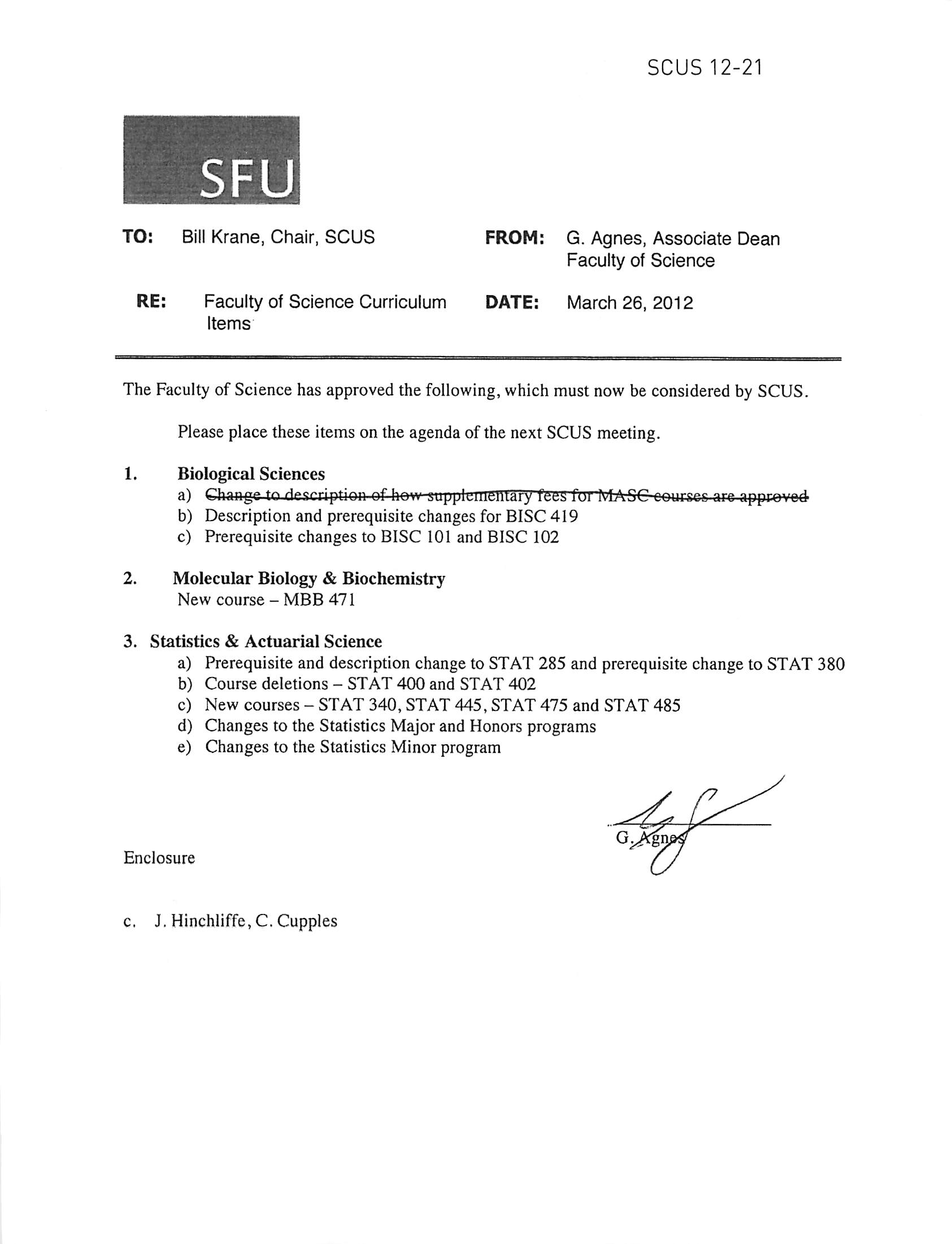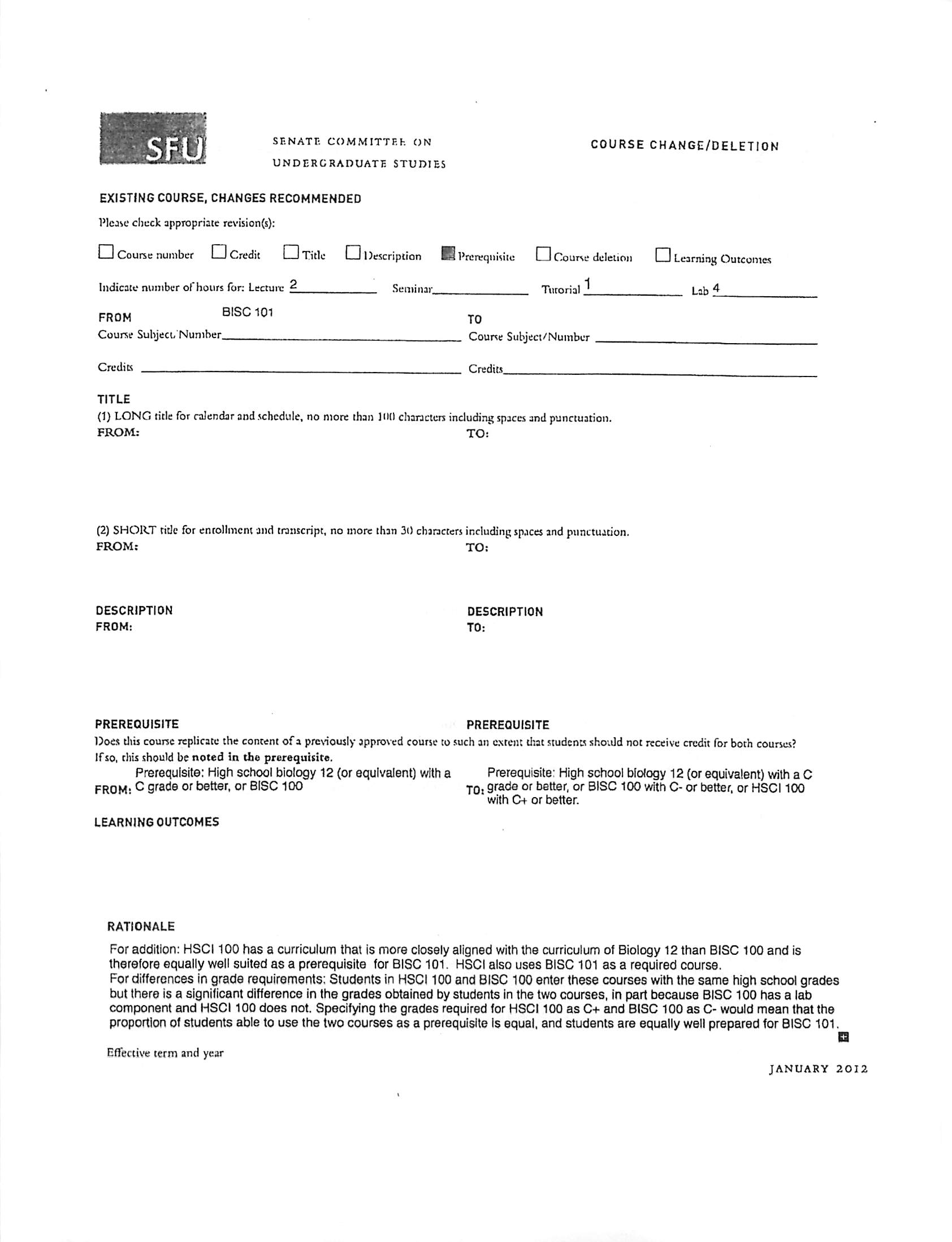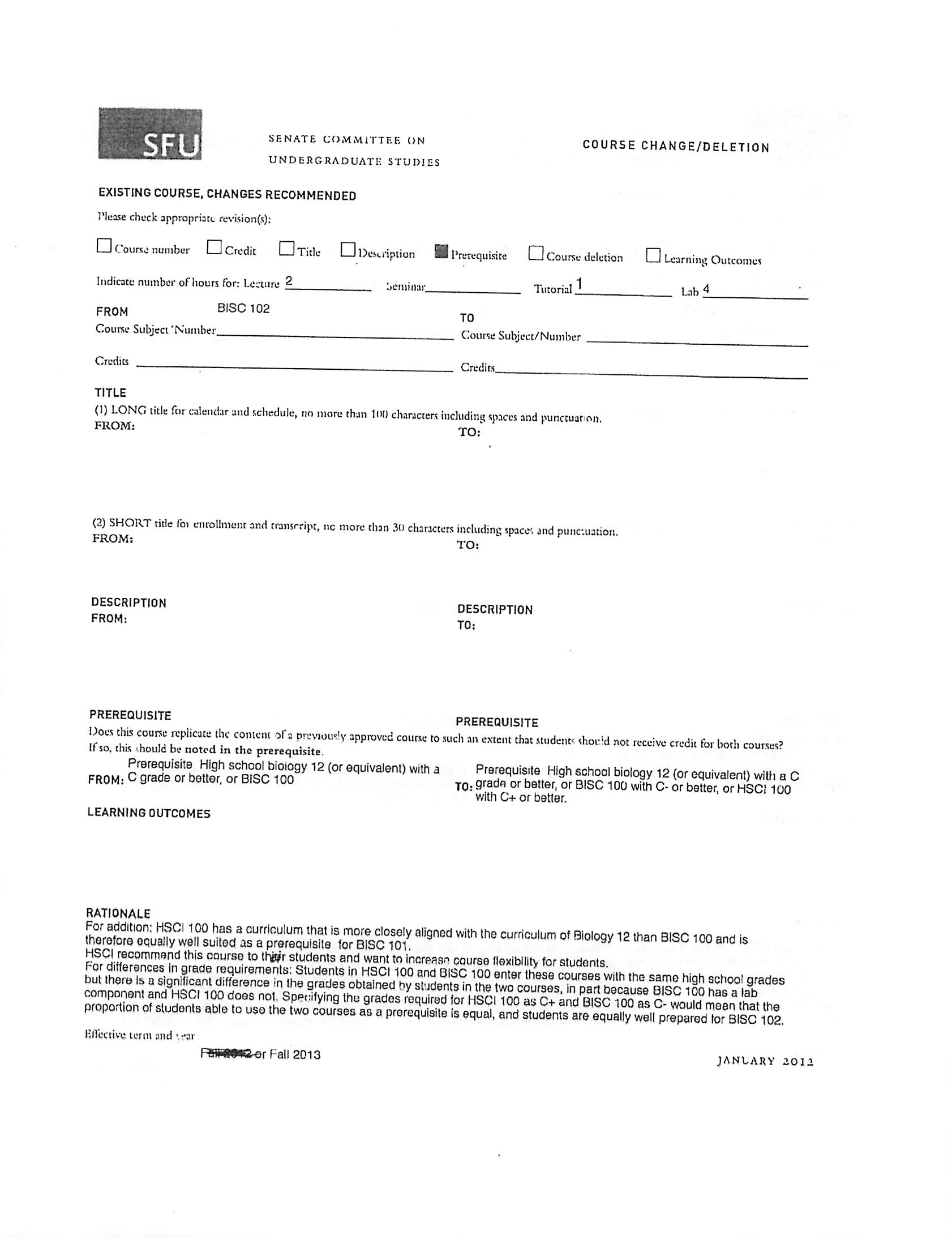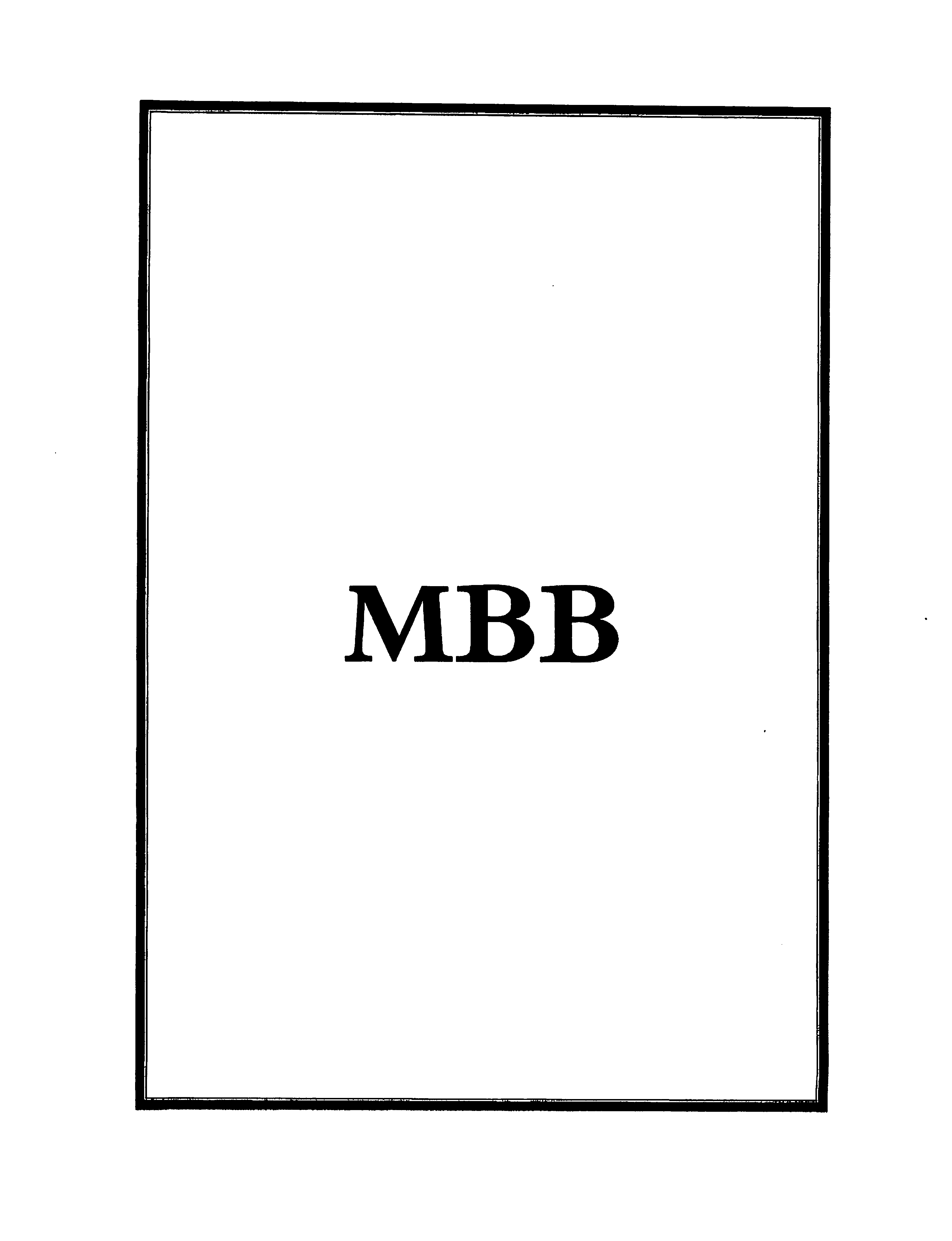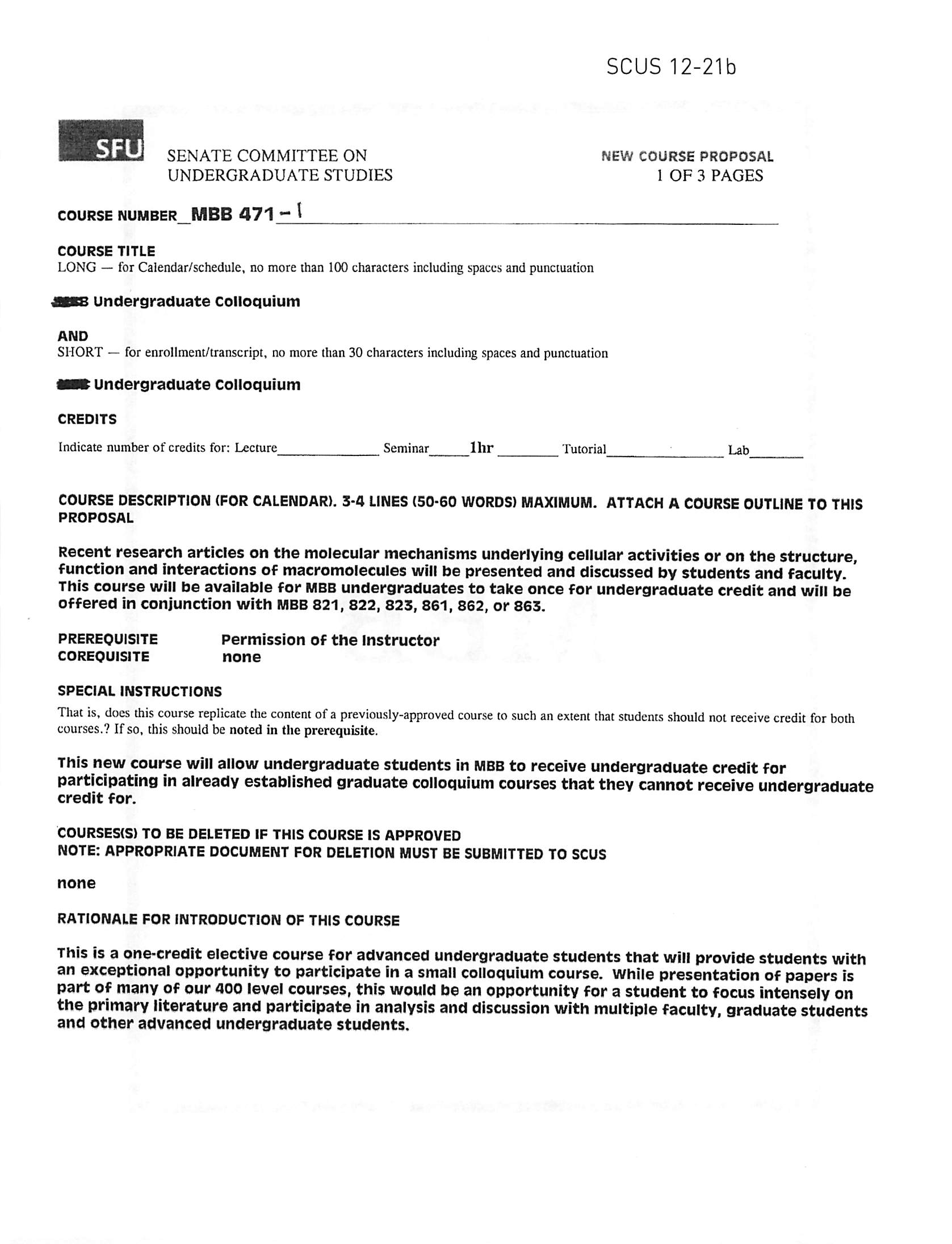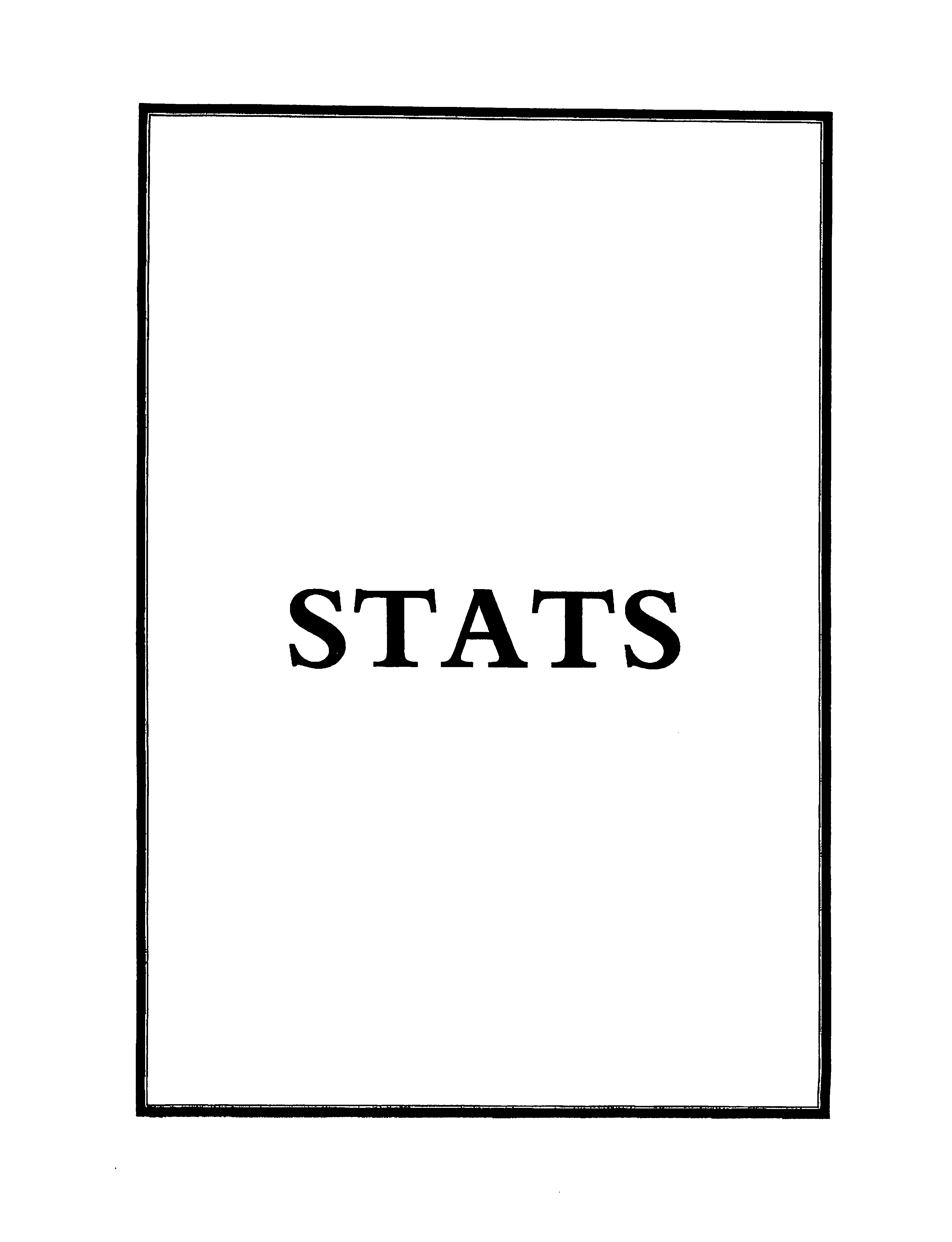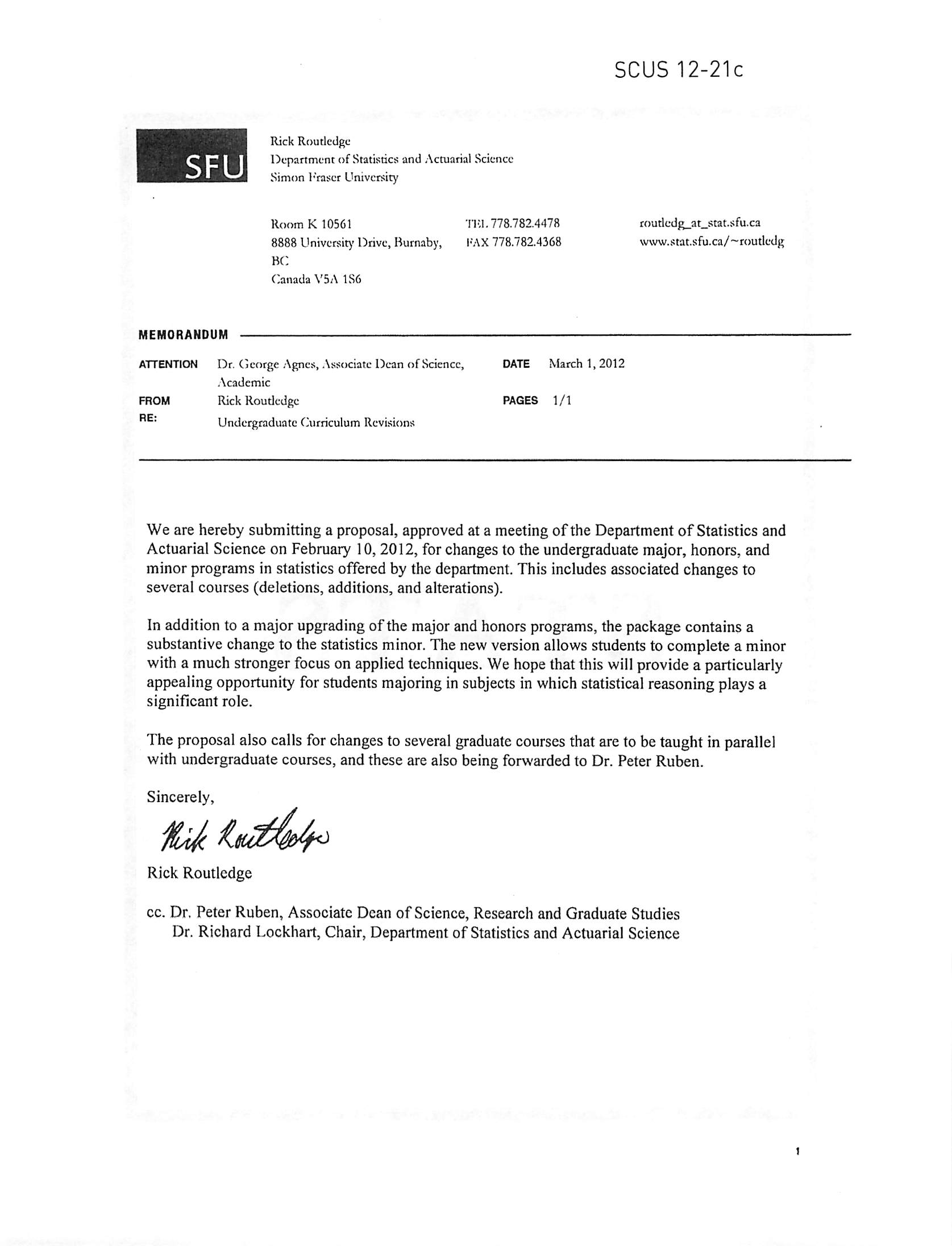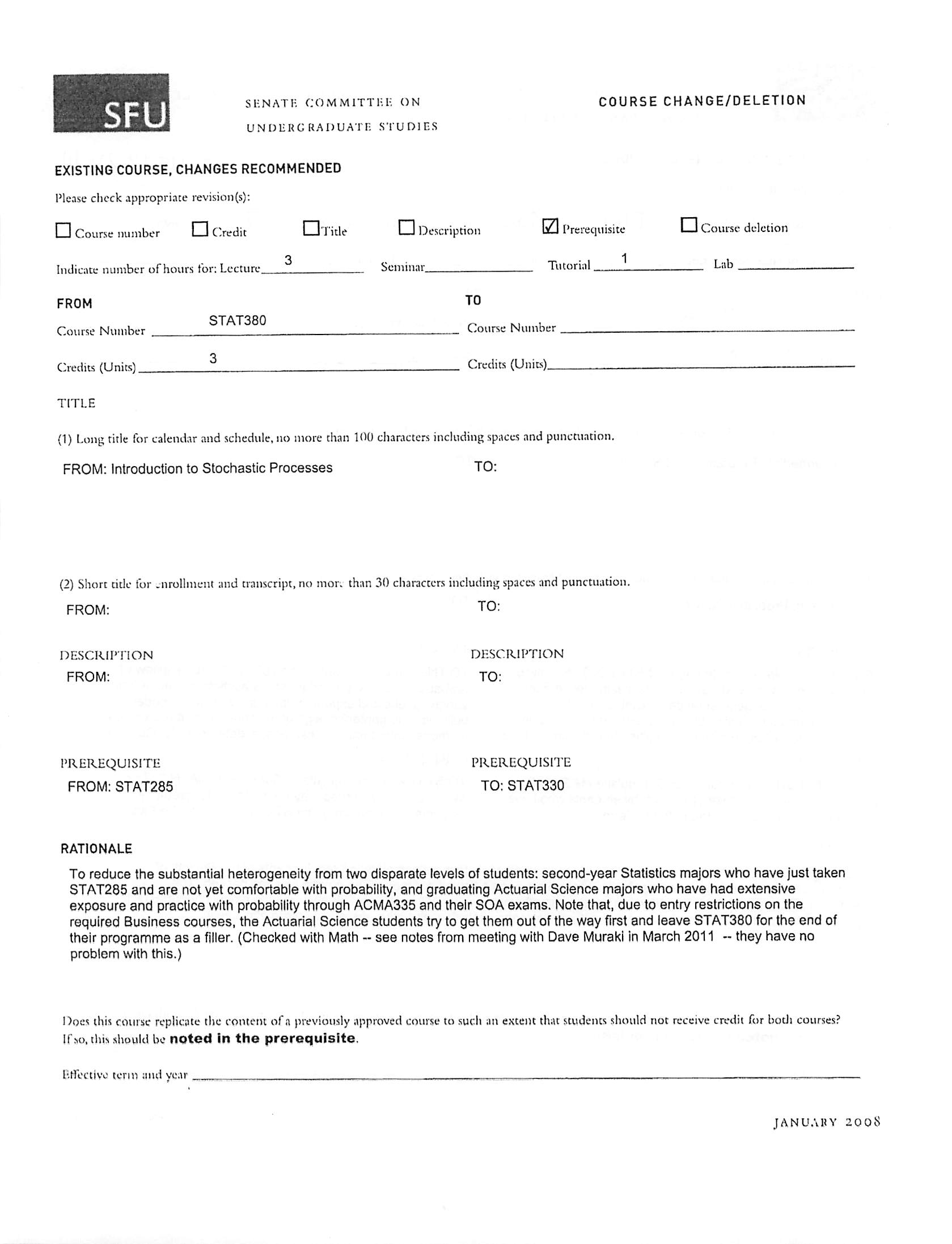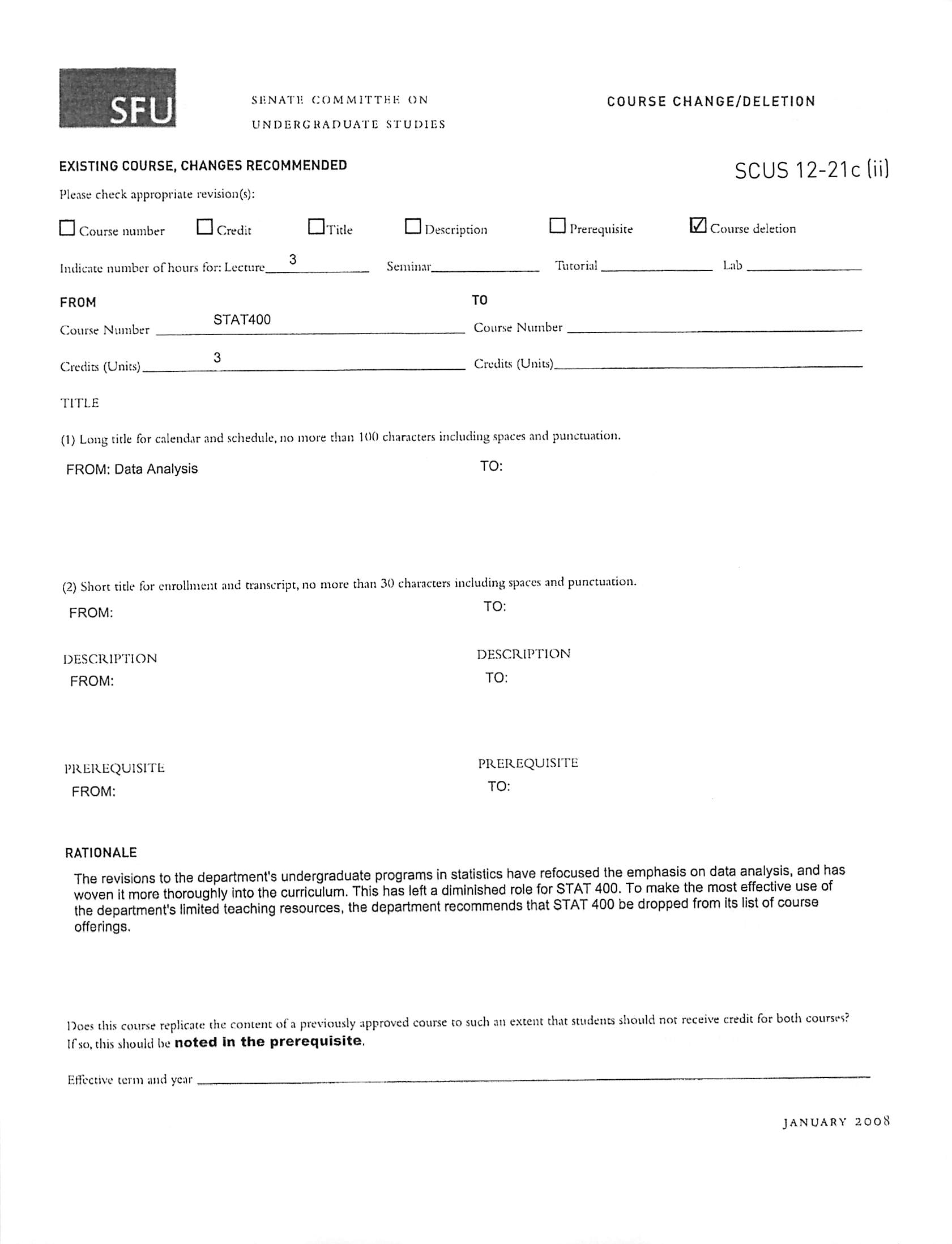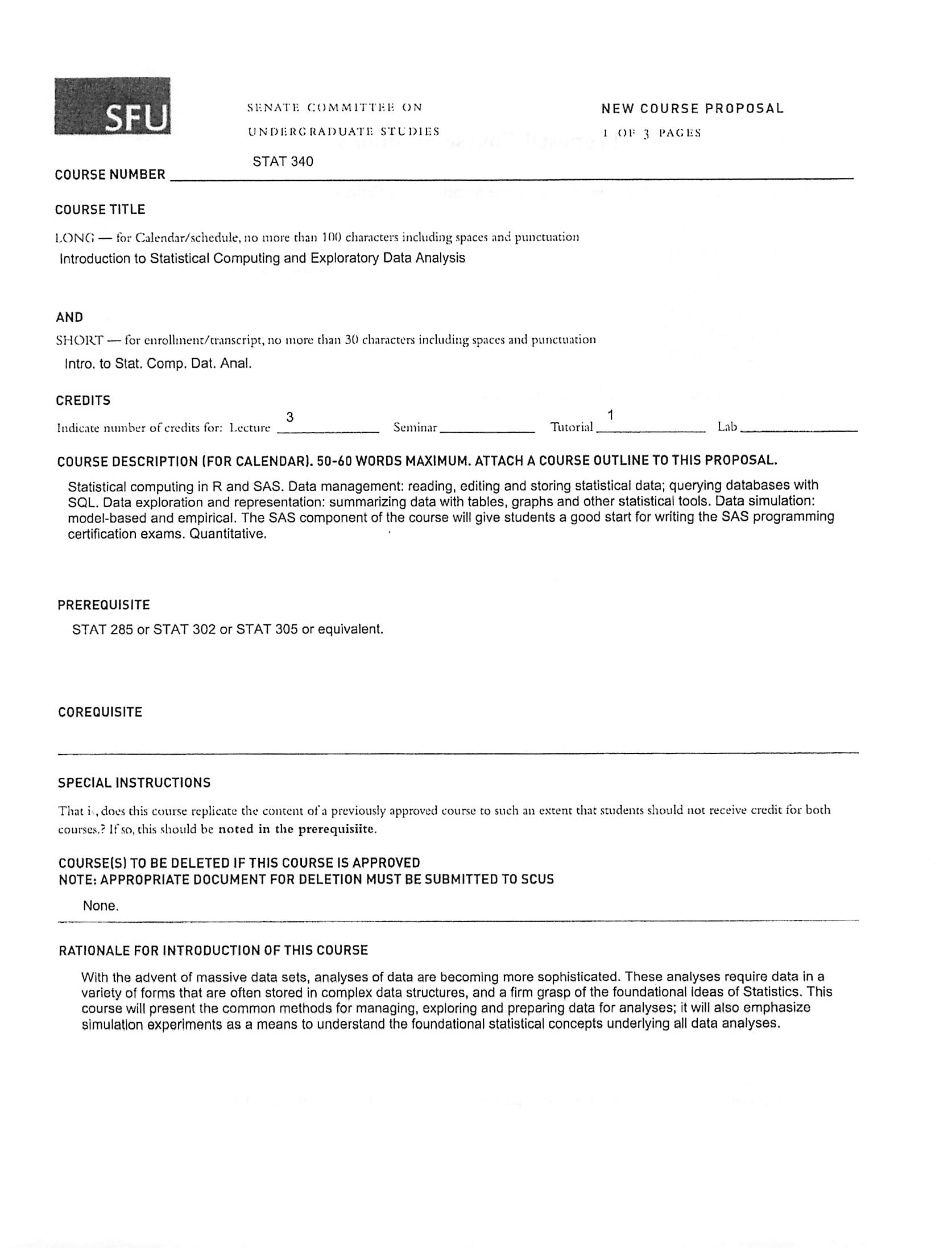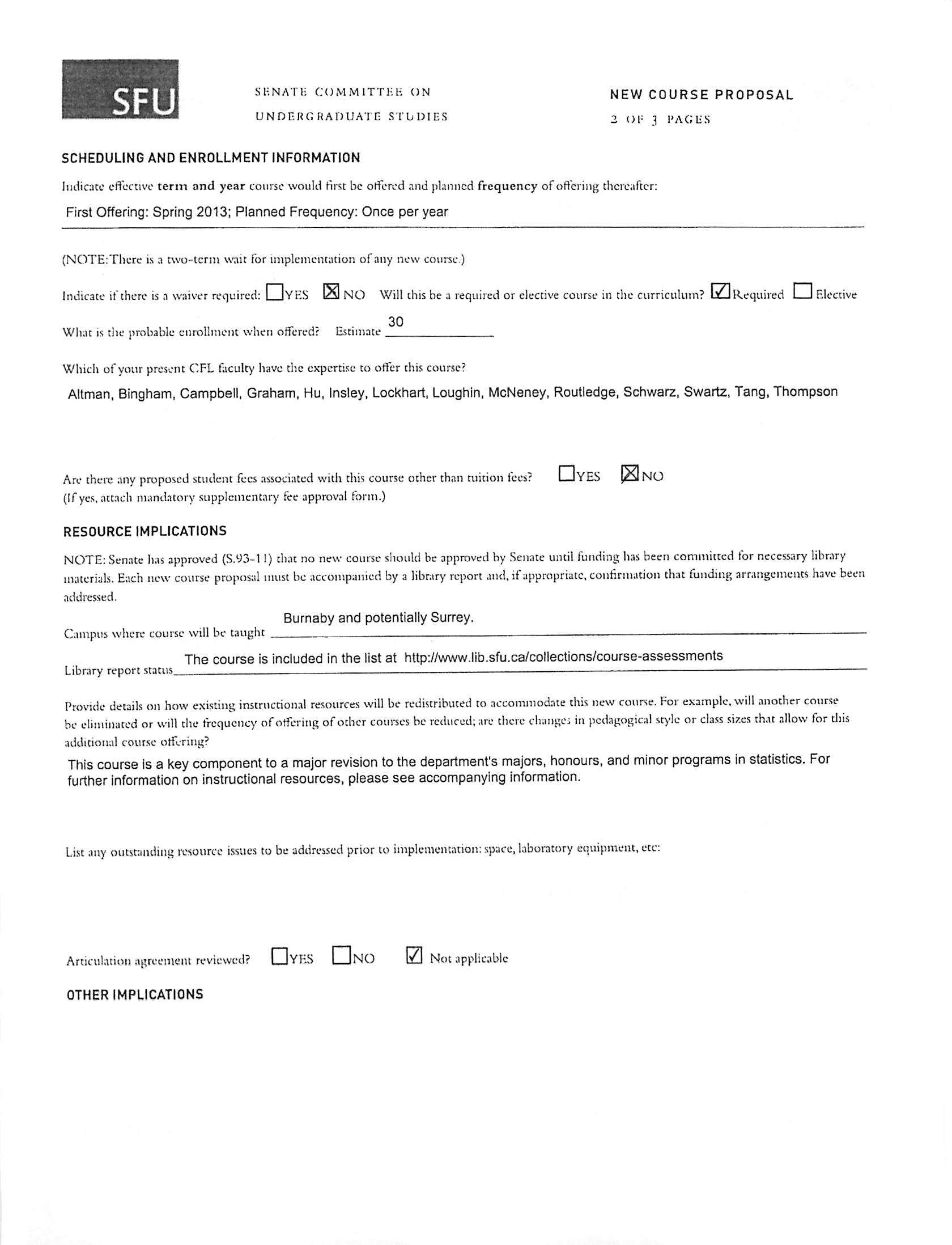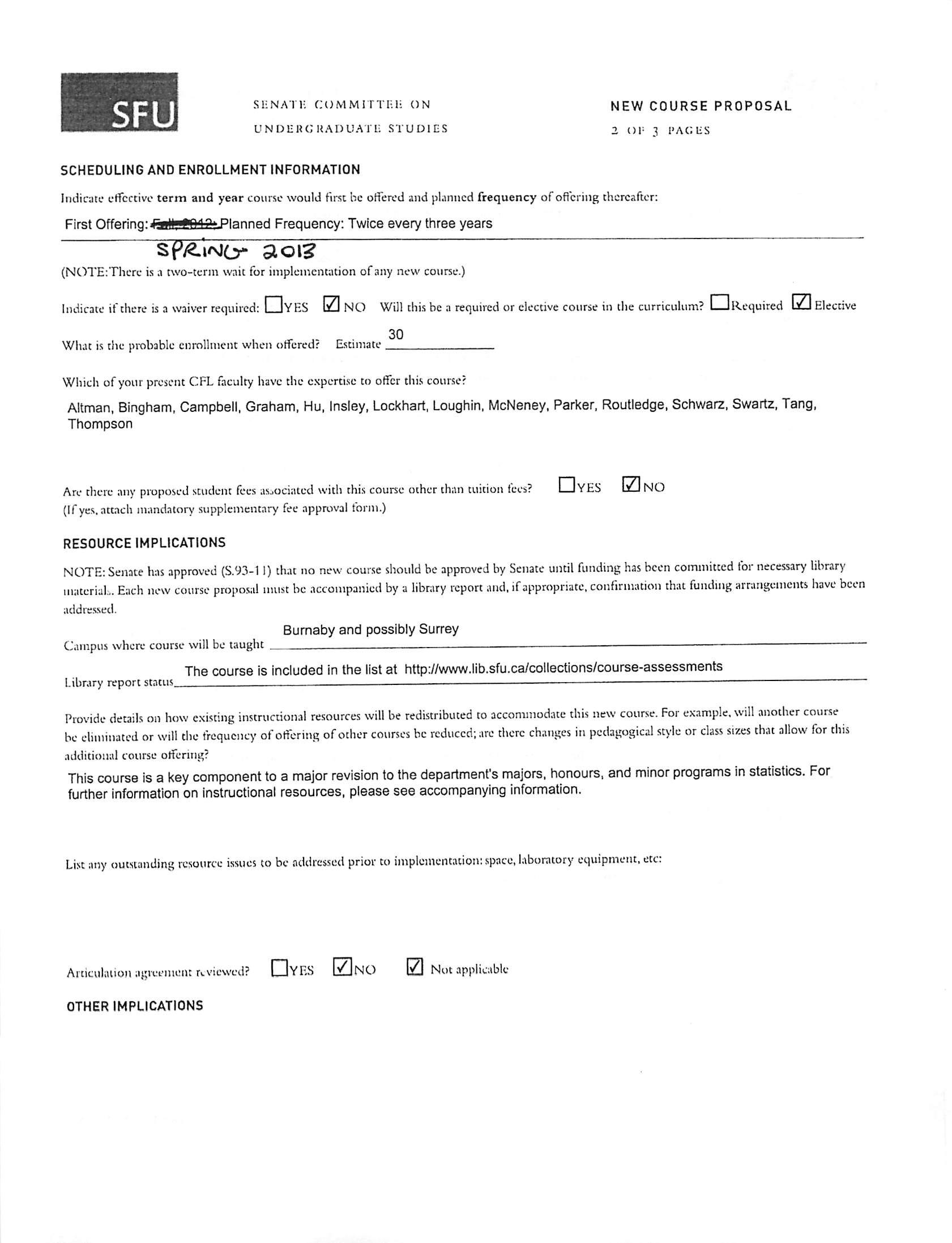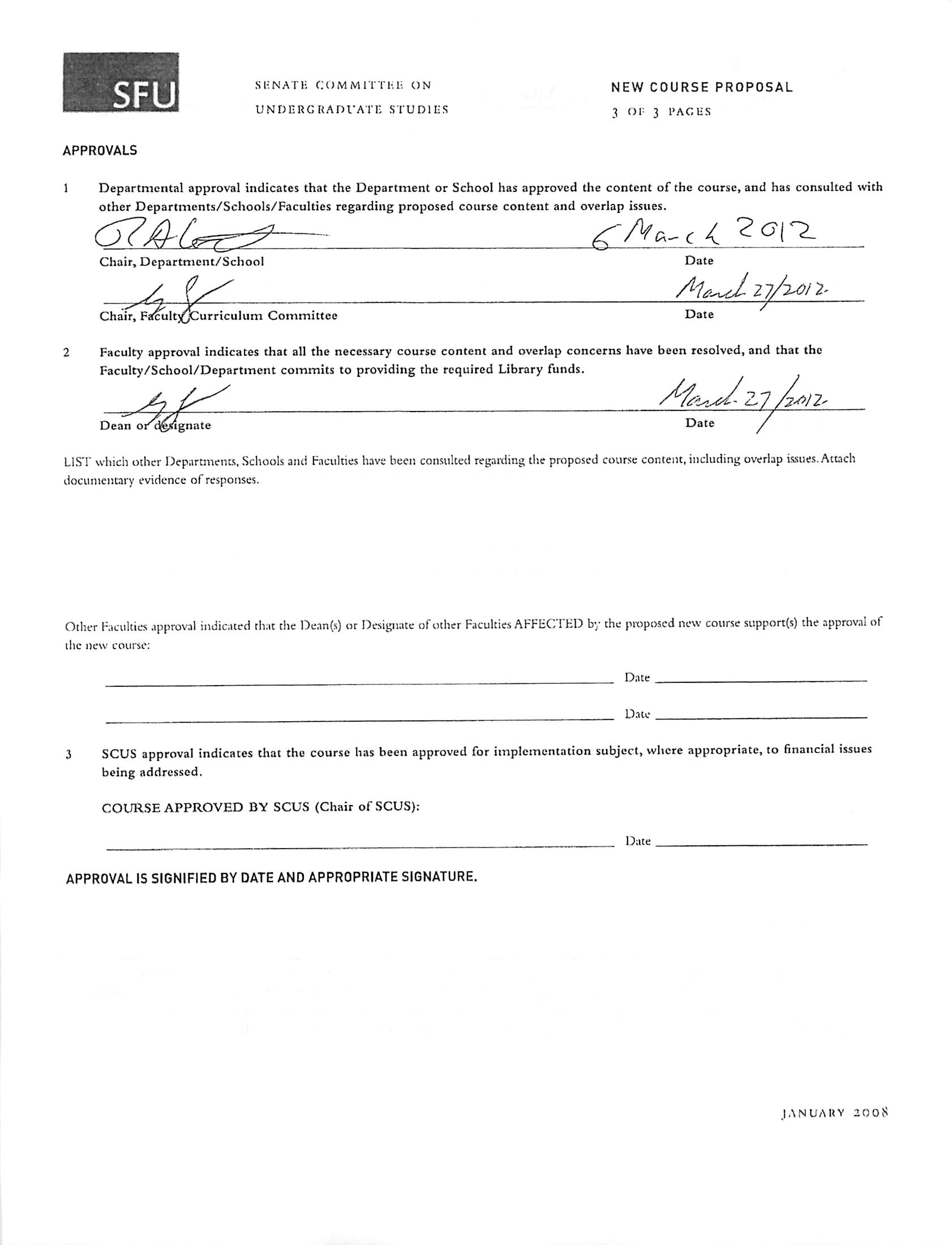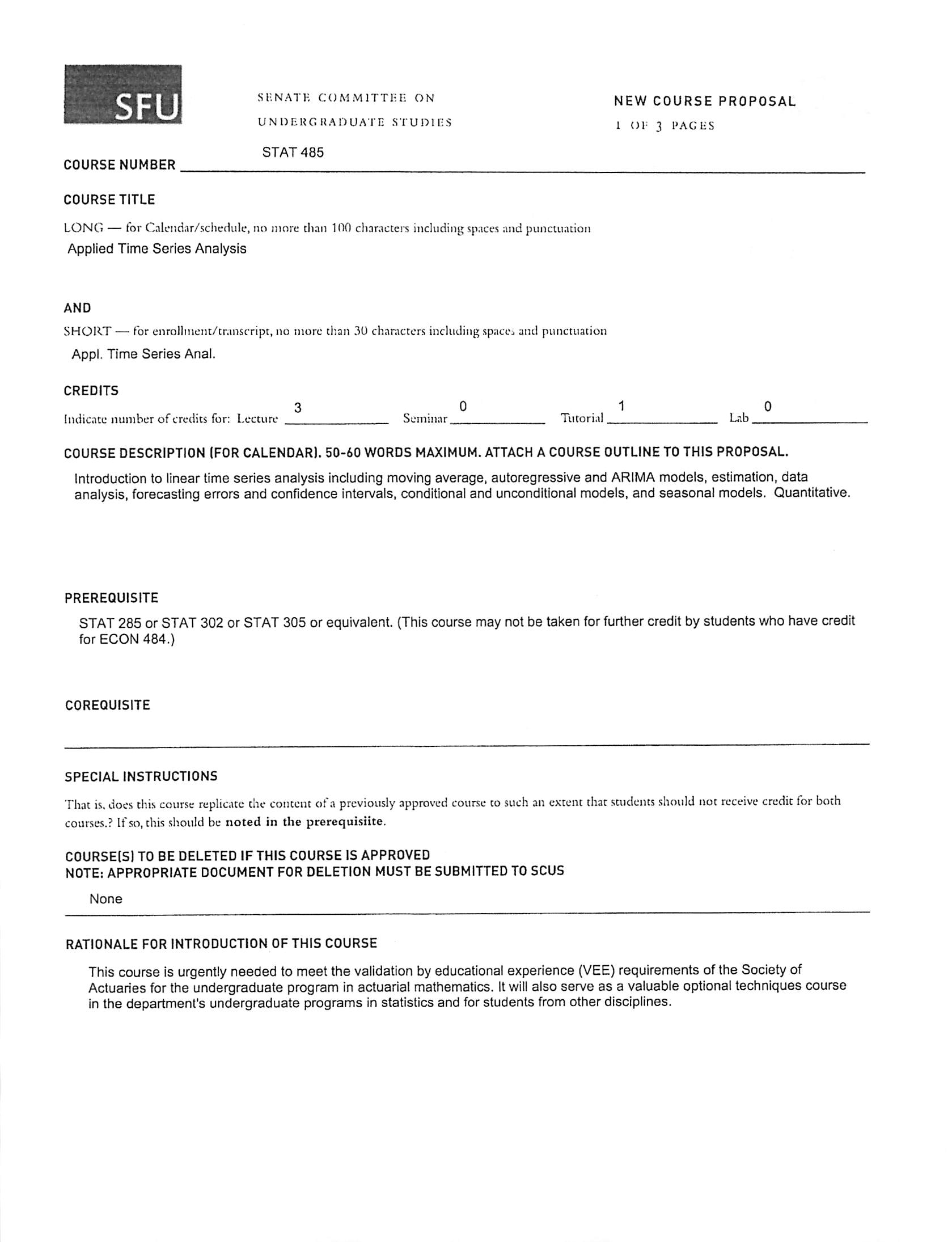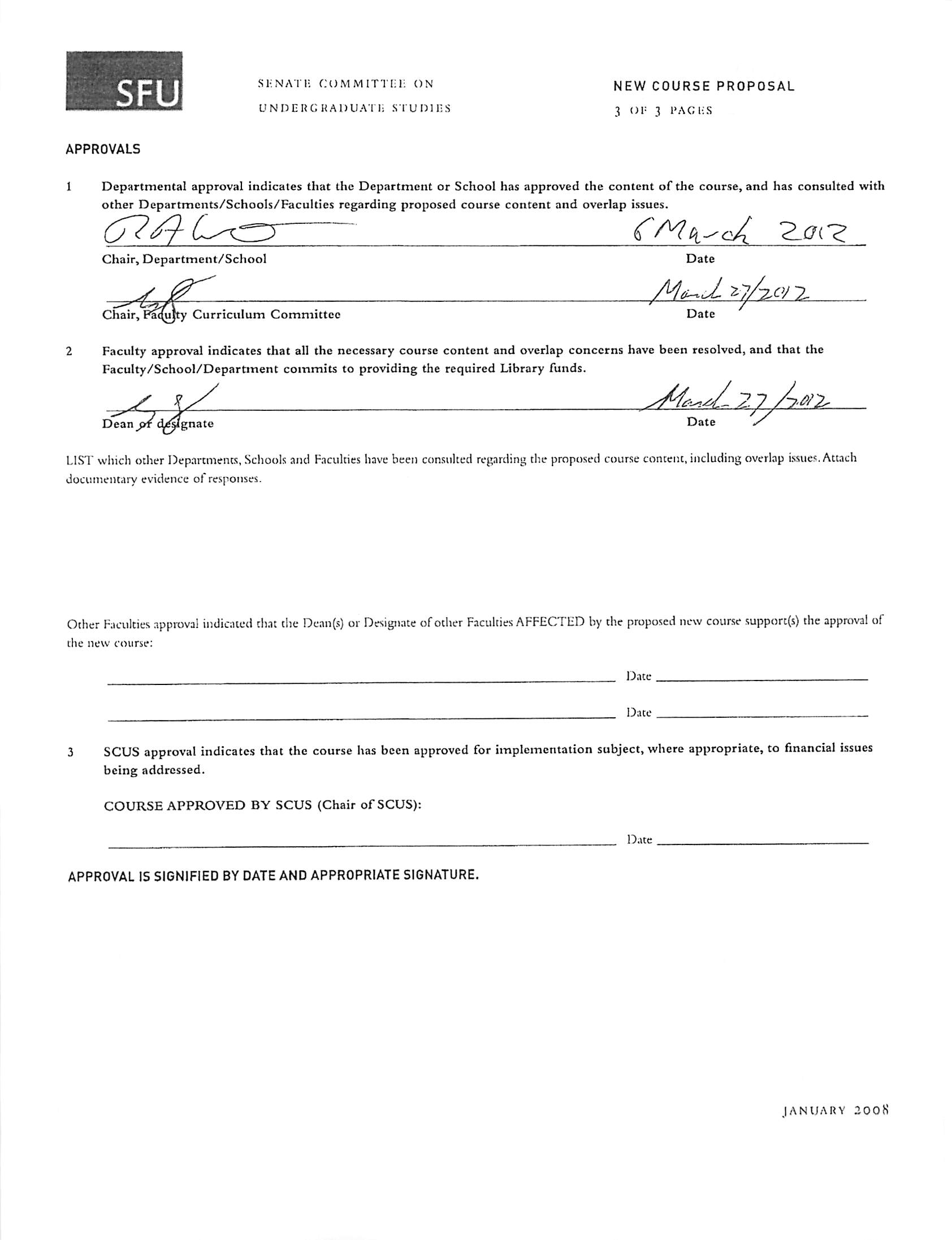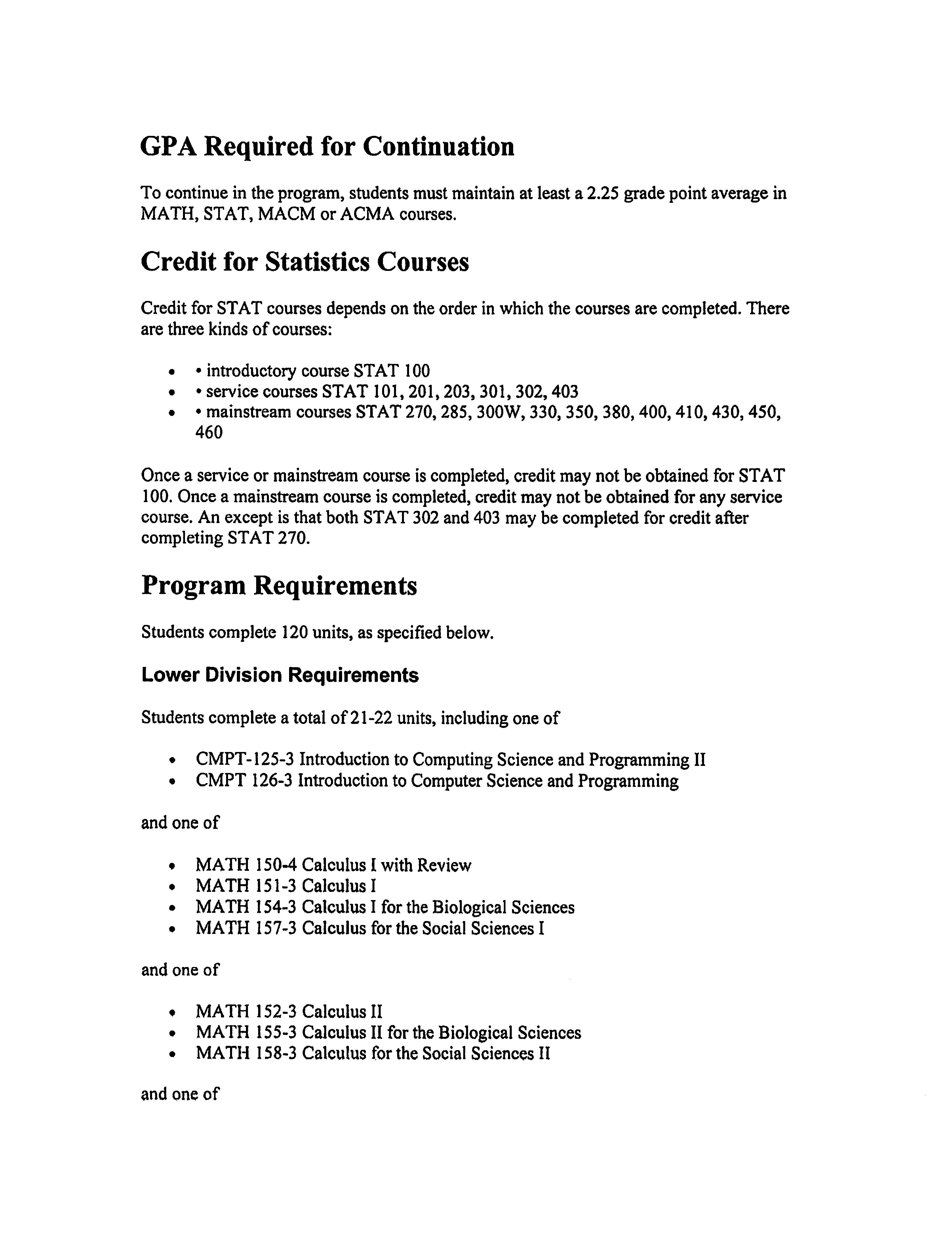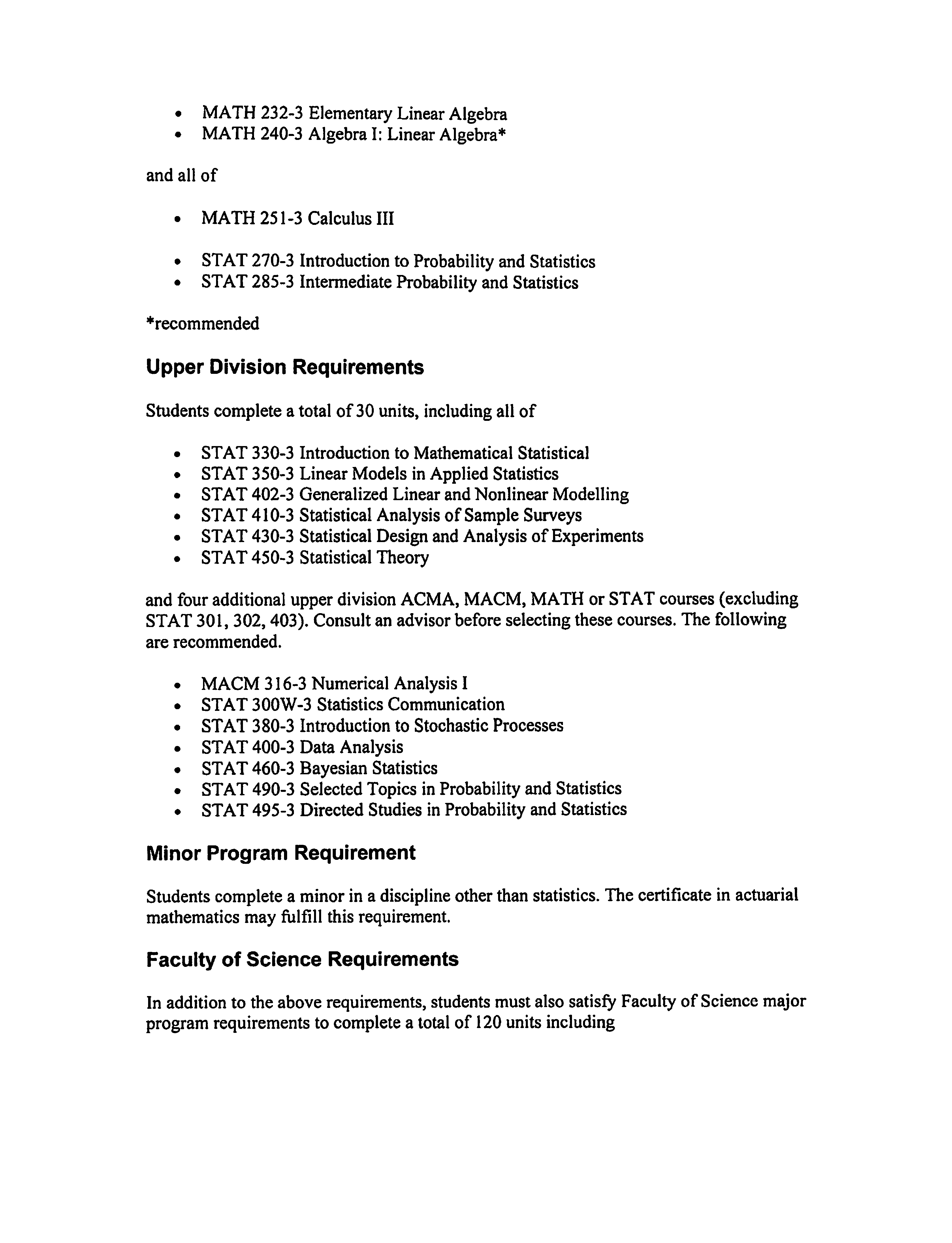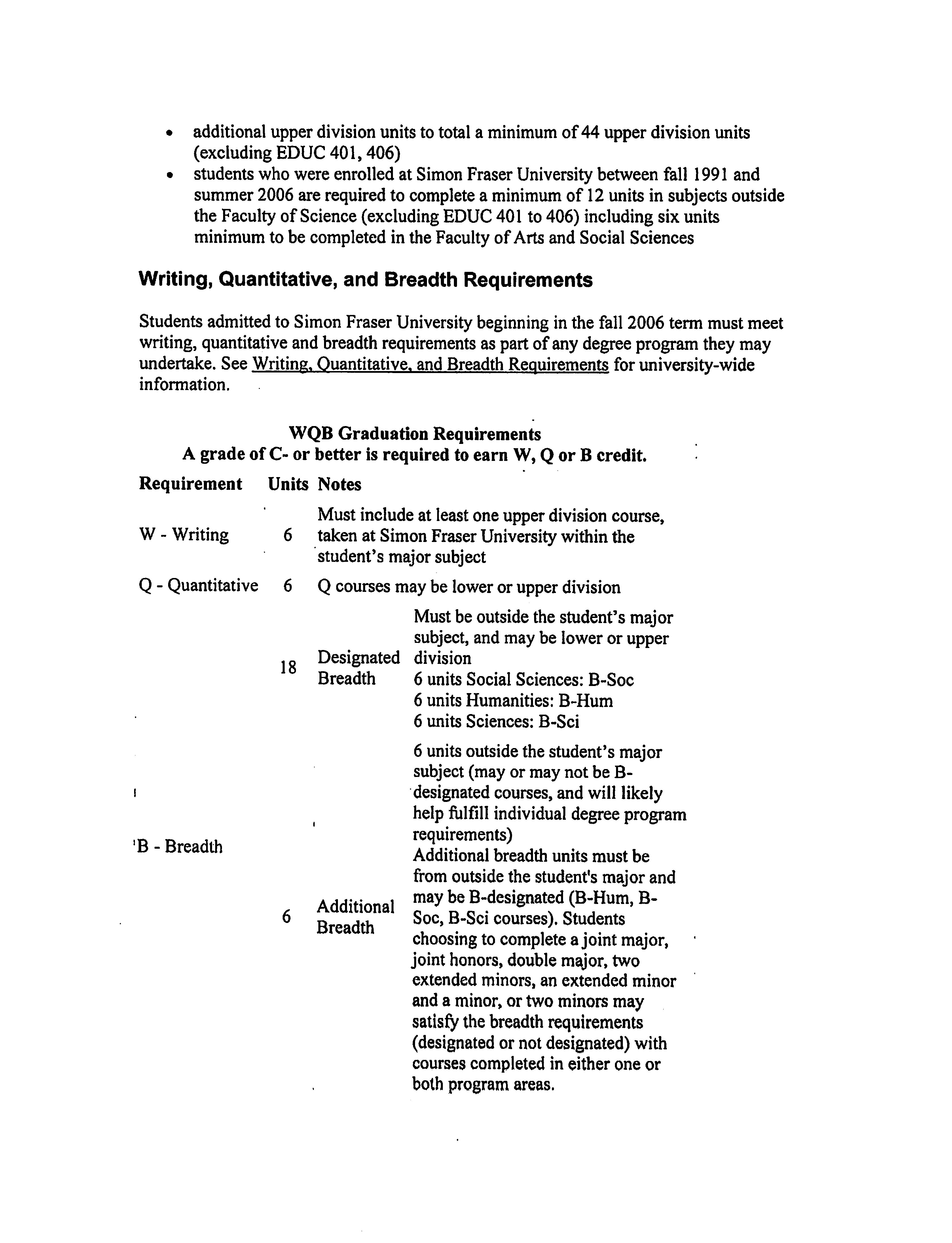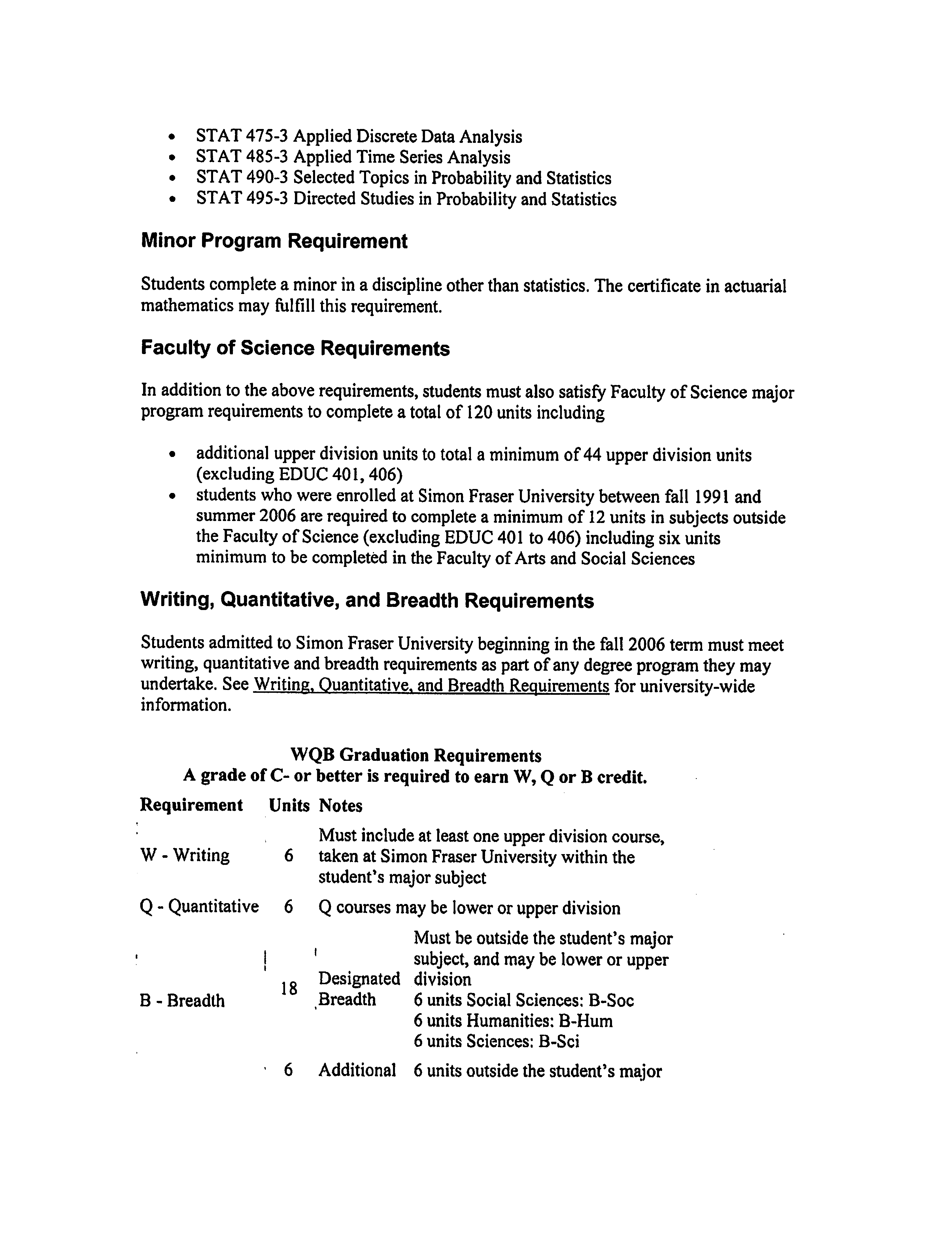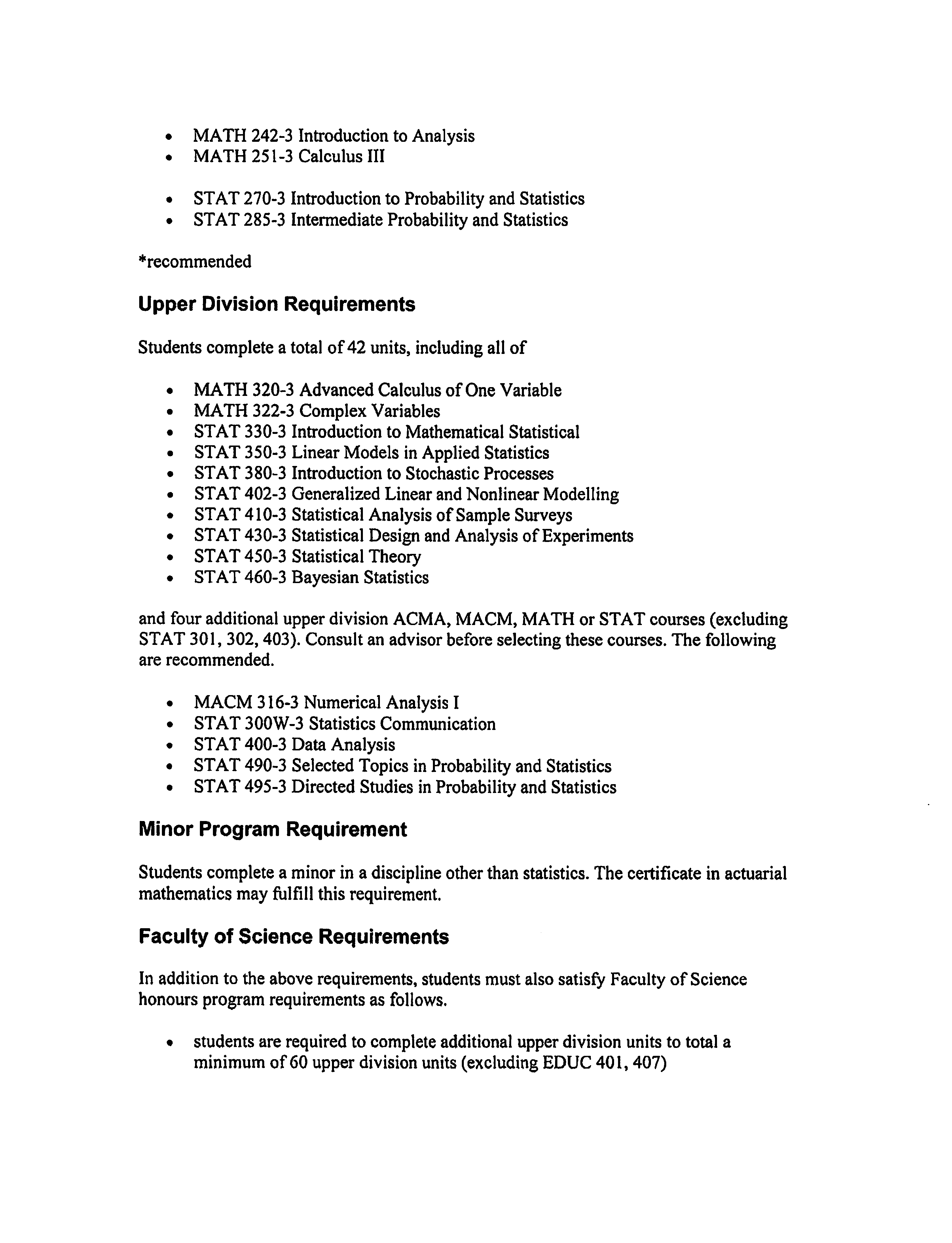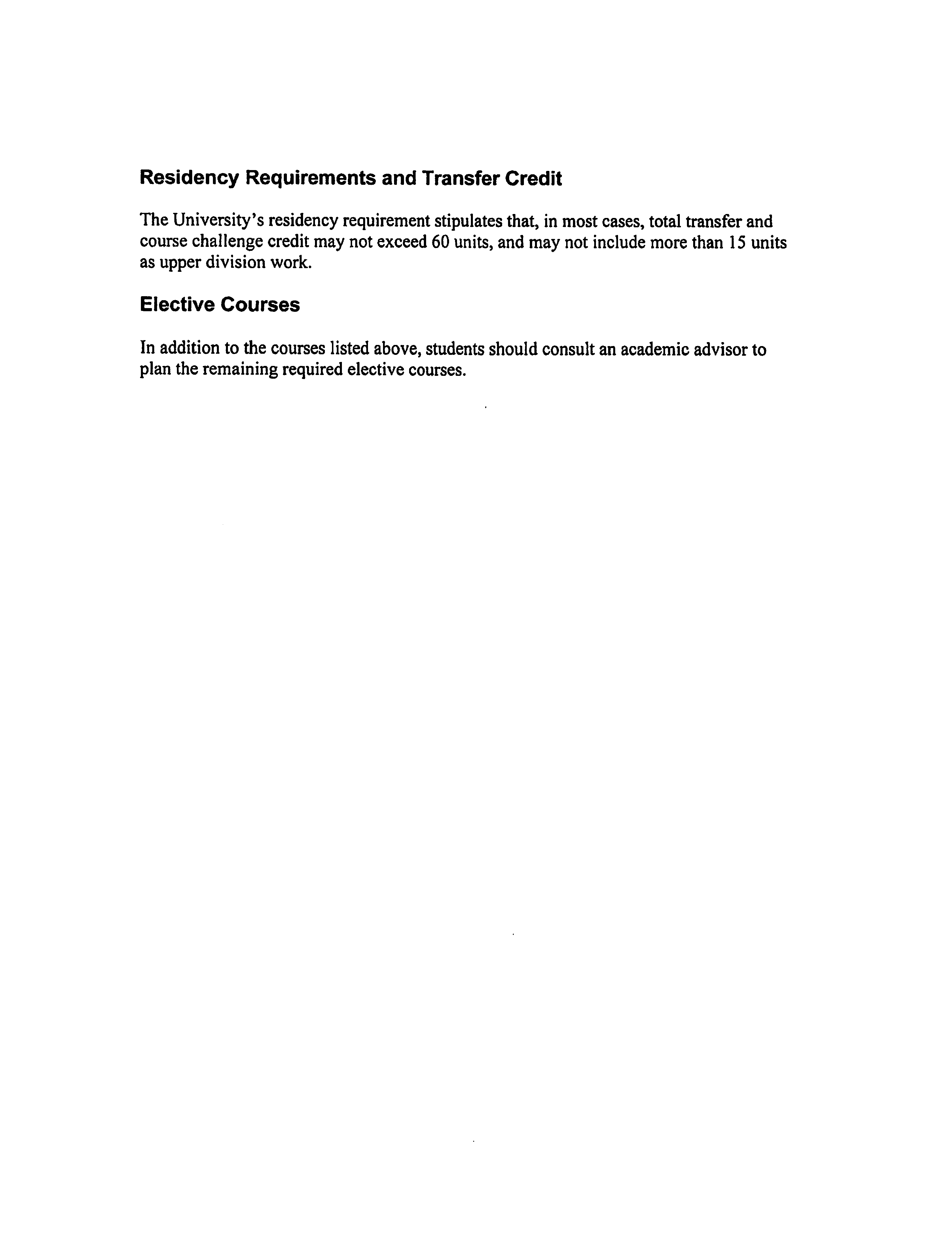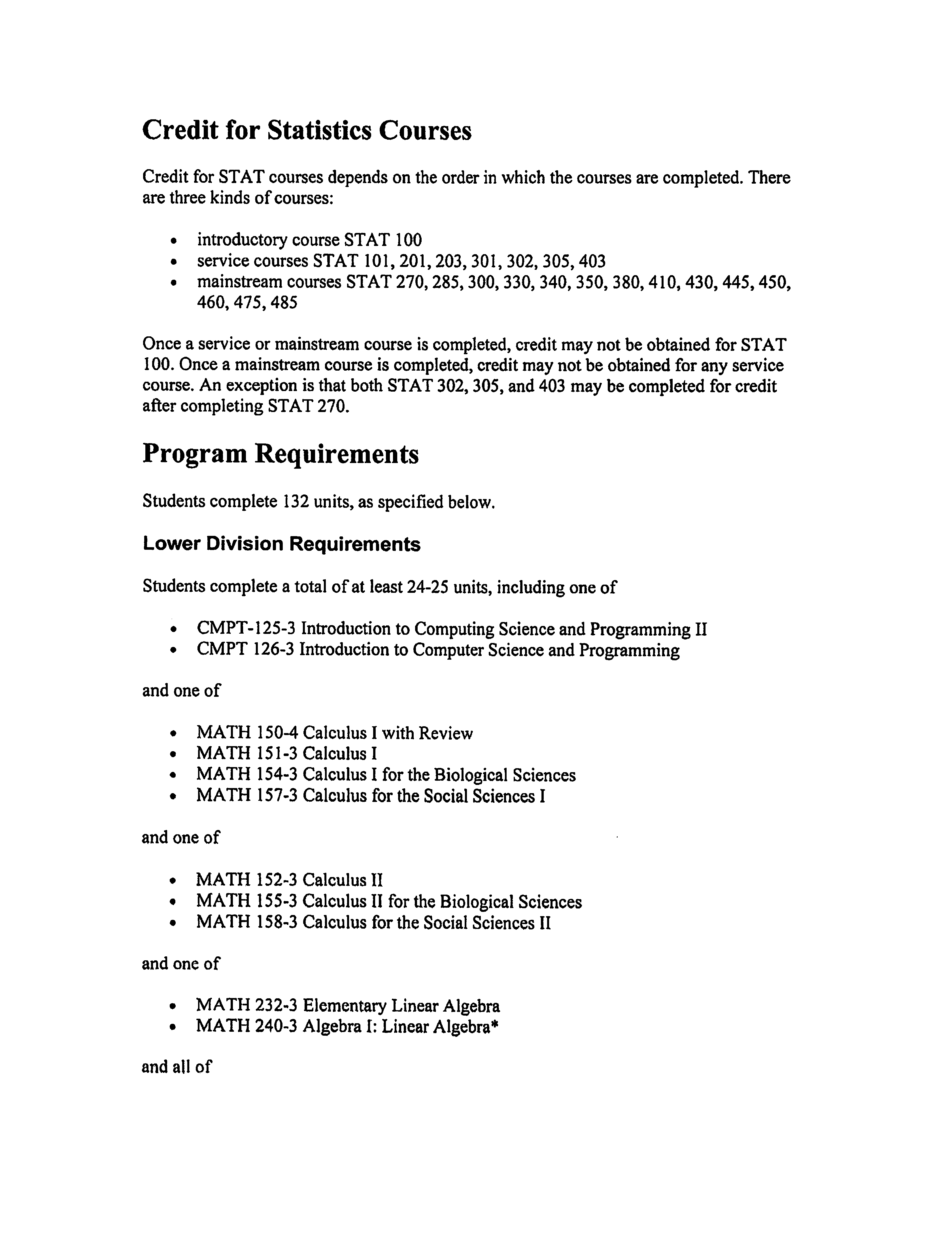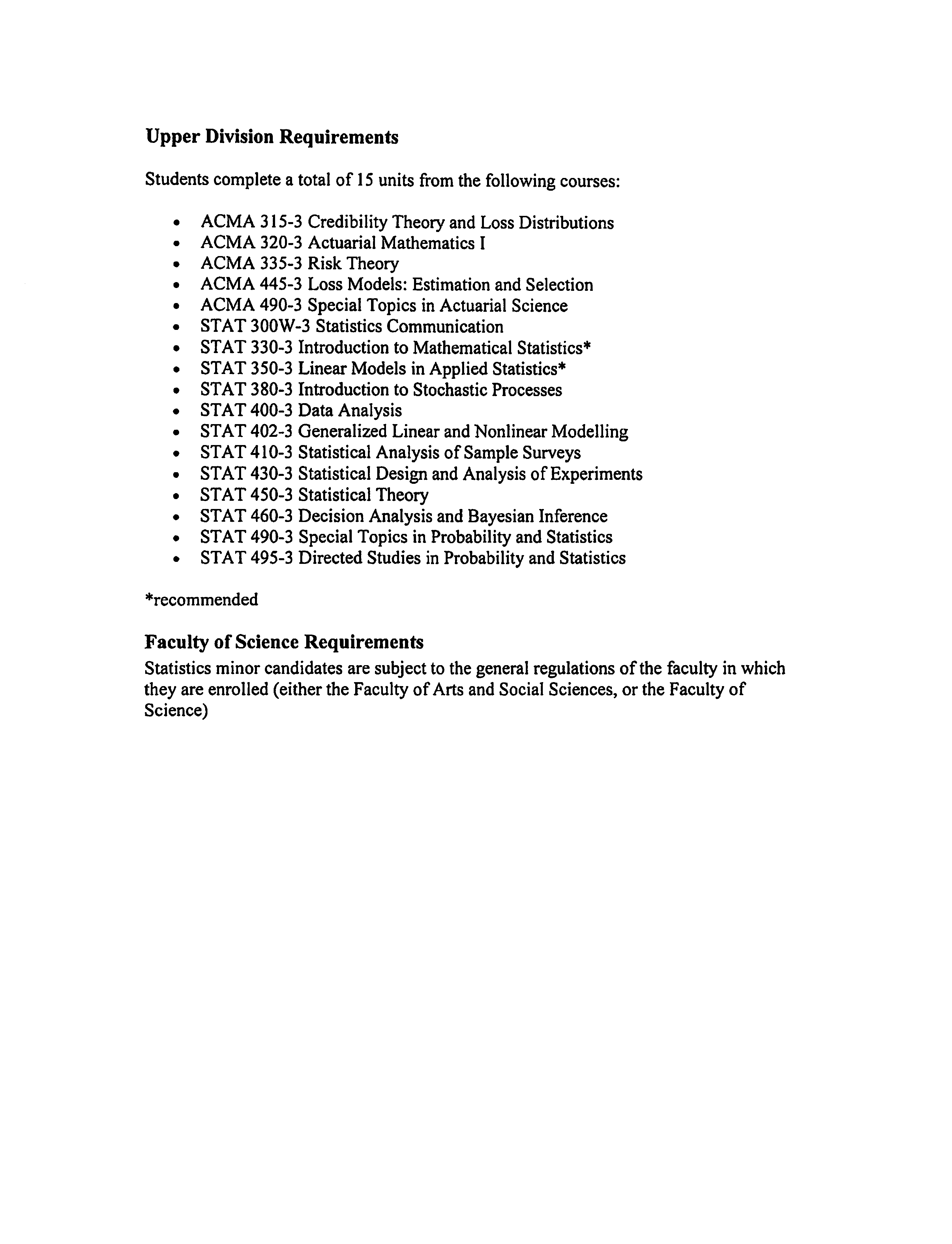SFU
MEMORANDUM
ATTENTION
FROM
RE:
S.12-80
OFFICE OF THE ASSOCIATE VICE-PRESIDENT, ACADEMIC AND
ASSOCIATE PROVOST
8888 University Drive,
Burnaby, BC
Canada V5A1S6
TEL: 778.782.4636
FAX: 778.782.5876
Senate
Bill Krane, Chair
Senate Committee on
Undergraduate Studies
Faculty of Science (SCUS 12-21
DATE
PAGES
www.sfu.ca/vpacademic
April 10,2012
1/1
For information:
Acting under delegated authority at its meeting ofApril 5, 2012, SCUS approved the
following curriculum revisions effective Spring 2013:
1. Department of Biological Sciences (SCUS 12-21a]
(i) Description and prerequisite change to BISC 419
(ii) Prerequisite changes to BISC 101, 102
2. Department of Molecular Biology and Biochemistry (SCUS 12-21 b)
(i) New Course Proposal: MBB 471, Undergraduate Colloquium
3. Department of Statistics and Actuarial Science (SCUS 12-21c)
(i) Prerequisite and/or description change to STAT 285, 380
(ii) Course deletions of STAT 400, 402
(iii) New Course Proposals:
STAT 340-3, Introduction to Statistical Computing and Exploratory Data Analysis
STAT 445-3, Applied Multivariate Analysis
STAT 475-3, Applied Discrete Data Analysis
STAT485-3, Applied Time Series Analysis
(iv) Changes to the Statistics Major and Honors Programs Upper Division
requirements
(v) Changes to the Statistics Minor Program Lowerand Upper Division requirements
Senators wishing to consult a more detailed report of curriculum revisions may do so by
going to Docushare: https://docushare.sfu.ca/dsweb/View/Collection-12682
If you are unable to access the information, please call 778-782-3168 or email
shellev gairOsfu.ca.
SIMON FRASER UNIVERSITY
THINKING OF THE WORLD
SCUS 12-21
SFU
TO:
Bill Krane, Chair, SCUS
FROM:
G. Agnes, Associate Dean
Faculty of Science
RE:
Faculty of Science Curriculum
DATE:
March 26, 2012
Items
The Faculty of Science has approved the following, which must now be considered by SCUS.
Please place these items on the agenda of the next SCUS meeting.
1.
Biological Sciences
a) Change to description of how auppluikWlaiy (te for MASC courses are approvod
b) Description and prerequisite changes for BISC 419
c) Prerequisite changes to BISC 101 and BISC 102
2.
Molecular Biology & Biochemistry
New course - MBB 471
3. Statistics & Actuarial Science
a) Prerequisite and description change to STAT 285 and prerequisite change to STAT 380
b) Course deletions - STAT 400 and STAT 402
c) New courses - STAT 340, STAT 445, STAT 475 and STAT 485
d) Changes to the Statistics Major and Honors programs
e) Changes to the Statistics Minor program
Enclosure
c. J. Hinchliffe,C. Cupples
David Green
Associate Professor
Chair,
Departmental
Undergraduate
Curriculum Committee
8888 University Drive,
Burnaby BC Canada
V5A IS6
TEL: 778.782.3981
FAX: 778.782.3496
EMAIL: djgreen@sfu.ca
SFU
Department of
Biological Sciences
SCUS 12-21a
ATTENTION : GeorgeAgnes
Faculty
of
Science
Undergraduate
Curriculum
Committee
FROM: David Green, Chair, Undergraduate Curriculum Committee
COPY: Felix Breden, Chair Department of Mathematics
RE: Calendar Changes
DATE: Feb 12012
Please find enclosed documents relating to undergraduate curriculum
changes approved by the Department of Biological Sciences on Jan 16 2012
to be considered at the next Faculty of Science Undergraduate Curriculum
Committee Meeting.
1. Thatn proposed ehango to how the cakudai describes huw supplementary
fees for MASC oourpon ic approvod.
0 Alter calendar entry to indieate studonts nood to contact
Bemfinlri Mnrinn Srinnr-nr fnnh-n
pegaf&ftg
fllipplcmcntary fcee -
2. That course description changes to BISC 419 be approved.
• Remove the statement that attendance on field trips is required
3. That prerequisite changes to BISC 101, BISC102 and BISC 419 be
approved
• Change the prerequisite of BISC 101 from
Prerequisite: High school biology 12 (or equivalent) with a C grade
or better, or BISC 100
to
Prerequisite: High school biology 12 (or equivalent) with a C grade
oi better, or BISC 100 with C- or bettor, or HSCI 100 with
C+
or
better.
• Change the prerequisite of BISC 102 from
Prerequisite: High school biology 12 (or equivalent) with a C grade
or belter, or BISC 100
to
Prerequisite: High school biology 12 (or equivalent) with a C grade
or better, or BISC 100 withC- or better, or HSCI 100 withOf or
better.
SIMON PHASED UNIVERSITY
THINKING OP THE WORLD
SFU
Department of
Biological Sciences
Change the preiequisite of BISC 419 from
Prerequisite: BISC 304. Recommended: BISC 316
to
Prerequisite: BISC 304. Recommended: BISC 316 and STAT 201
SIMON FRASER UNIVERSITY
THINKING OF THE WORLD
SFU
SENATF COMMITTEE ON
COURSE CHANGE/DELATION
UNDERGRADUATE STUDIES
EXISTING COURSE, CHANGES RECOMMENDED
Please check appropriate revision(s):
U Course number
U Credit
• Title
• Description
• Prerequisite
D Course deletion
D Learning Outcomes
Indicate number of hour'for: L-cture 5
Seininar_
Tutorial
Lai 3
FR0M
BISC 419 (Wildlife Biology)
TQ
Course
Subject/Number
Course
Subject/Number
Credits
Credits
TITLE
(1) LONC; title for calendar and schedule, no mow than 10i> characters including spaces and punctuation.
FROM:
TO:
(2) SHORT title (or enrollmeu; and transcript, no move than 30 characters including spaces and punctuation.
FROM:
TO:
DESCRIPTION
DESCRIPTION
FROM:
T0.
Theoretical
relation
to
wildlife
and
applied
populates
aspects
and
of
theirecologyhabitats,and
behavior
with
emphasis
in
Theoreticalrelation
to
wildlife
and
appliedpopulations
aspects
and
of
theirecology
habitatsand
behavior
ilh
emohasle
in
on local'field
T£™e
Sled
C°'Umbia- Attendance
on imPor,anl mam™'s and birds
*
Brftlsh Columbia
P
PREREQUISITE
PREREQUISITE
Does this cou,* replicate the content of a previously approved course to snch an extent that students should not receive credit for both coursed
If so, this should be noted in the prerequisite.
Prerequisite: BISC 304. Recommended BISC 316
Prerequisite: BISC 304. Recommended: BISC 316 and STAT
FROM:
-J-Q. 201
LEARNING OUTCOMES
RATIONALE
Change lo course description: Field trips are not offered every time this course is taught
SSThrytfSlwSS,a"SliCa' ana'VSiS °'** C°I"'C"", by 5'UdMSSnd SUden'S™ou,d be b81tef P«P«-<°'
Elfi etivt term jnd year
rull'Qfttf Ul- Fall 2013
JANUARY 20f2
SFU
SENATE COMMITTEE ON
UNDERGRADUATE STUDIES
COURSE CHANGE/DELETION
EXISTING COURSE, CHANGES RECOMMENDED
Please check appropriate revision(s):
I—I Course number
I—I Credit
I—I Title
I I Description
E Prerequisite
Indicate number of hours for: Lecture _
Seminar_
FROM
8ISC1°1
TO
Course
Subject/Number
Course
Subject/Number
Credits
Credits,
I—I Course deletion
1
Tutorial
TITLE
(1) LONG title for calendar and schedule, no more than
1(1(1
characters including spaces and punctuation.
FROM:
TO:
(2) SHORT tide for enrollment and transcript, no more than 3D characters including spaces andpunctuation.
FROM:
TO:
DESCRIPTION
FROM:
DESCRIPTION
TO:
I—I Learning Outcomes
Lab
PREREQUISITE
PREREQUISITE
Does this course replicate the content of a previously approved course to such an extent d;at students should not receive credit for both courses?
Ifso, this should be
noted in the prerequisite.
Prerequisite: High school biology 12 (or equivalent) with a
Prerequisite' High school biology 12 (or equivalent) with a C
FROM: c 9rade or better, or BISC 100
T0,9rade or better, or BISC 100 with C- or better, or HSC1100
' with C+ or better.
LEARNING OUTCOMES
RATIONALE
For addition: HSC1100 has a curriculum that is more closely aligned withthe curriculumof Biology 12 than BISC 100 and is
therefore equally well suited
as a prerequisite for BISC101. HSCIalso uses BISC101 as a required course.
Fordifferences in grade requirements: Students in HSC1100 and BISC 100 enter these courses with the same high school grades
but there is a significantdifference in the grades obtained bystudents in the twocourses, in part because BISC 100 has a lab
component and HSC1100 does not. Specifying the grades required for HSC1100 as C+ and BISC 100 as C- would mean that the
proportion of students able to use the two courses as a prerequisite is equal, and students are equally wellprepared for BISC 101.
Effective
term and year
JANUARY 2012
SFU
SENATE COMMITTEE ON
UNDERGRADUATE STUDIES
COURSE CHANGE/DELETION
EXISTINGCOURSE,CHANGES RECOMMENDED
Please
check
appropriate
revision(s):
G Course number
Q
Credit
• Title
D Description
• Prerequisite
D Course deletion
• Learnin, Ou
1
Indicate number of hours for: Lecture _
FROM
BISC 102
Course
Subject
'Number,
—
Tutorial _.
TO
Course Subject/Number
Credit.*.
Credits
TITLE
FROM:
(1)
LONG
title
for
calendar
and
schedule,
no
more
than
UK)
characters
including
to.
spaces
'
and
punctuator].
FROM:
(2)
SHORT
title
foi
enrollment
and
transcript,
no
more
than
3d
characters
TQ:
including
-P
spaces
and
DESCRIPTION
FROM:
DESCRIPTION
TO:
PREREQUISITE
PREREQUISITE
Does this course replicate the content ofa previously approved course to such an ext
If so. this hould be noted in the prerequisite.
FROM-
f-ROM.
oSSTtJffSmD^
ynue
or
oeuer,
or
blbO
100
"
^
eqUiVa'ent>
W'th
a
TQ:
fSSTn
gradn
or
better
Hl9h
or
52?
B|sc
1fJfJ
bi°,09y
wjm
c
12
Qf
{°r
fa
GquiValent>
£
Wij"
a
0
with C+ or better.
LEARNING OUTCOMES
punctuation.
1115 Outcomes
Lab
vtent that student" shord not receive credit for both courses?
RATIONALE
^£eZ^^!^^^^:S^^^
ali9nCd With lhe «*"*« " •** 12 than BISC 100 and is
S
For
rt2S2SI!S
differences
in
grade
'hlsrlcourse
requirements:
t0
th»r
studantaStudents
and
in
HSC1100want
to
increase
and
BISC
course
100
flexibility
enter
these
for
coursesstudents
v
but the.e Is a significant difference in the grades obtained hyshdents in the two
with
'
the same high school grades
proportion o, stodon.s aO,e ,o uso ft, two SSuSU. a! a pn»S*S h«3
Z m^J^S^SStSmSSt
Kllective term and •ear
nil fHHUer Fall 2013
JANUARY 2012
SFU
SCUS 12-21b
SENATE COMMITTEE ON
NEW COURSE PROPOSAL
UNDERGRADUATE STUDIES
1 OF 3 PAGES
COURSE NUMBER
MBB 471
- »
COURSE TITLE
LONG — for Calendar/schedule, no more than 100 characters including spaces and punciuation
atss
undergraduate colloquium
AND
SHORT — for enrollment/transcript, no more than 30 characters including spaces and punctuation
tt~t
Undergraduate Colloquium
CREDITS
Indicate numberof credits for: Lecture
Seminar
lhr
Tutorial
Lab
COURSE DESCRIPTION (FOR CALENDAR). 3-4 LINES (50-60 WORDS) MAXIMUM. ATTACH A COURSE OUTLINE TO THIS
PROPOSAL
Recent research articles on the molecular mechanisms underlying cellular activities or on the structure,
function and interactions of macromolecules
will be presented and discussed by students and faculty.
This course will be available for mbb undergraduates to take once for undergraduate credit and will be
offered in conjunction with mbb 821, 822, 823,861, 862, or 863.
prerequisite
Permission of the Instructor
corequisite
none
SPECIAL INSTRUCTIONS
That is, docs this course replicate the content of a previously-approved course to such an extent that students should not receive credit for both
courses.? If so, this should be
noted in the prerequisite.
This new course will allow undergraduate students in mbb to receive undergraduate credit for
participating in already established graduate colloquium courses that they cannot receive undergraduate
credit for.
COURSES(S) TO BE DELETED IF THIS COURSE IS APPROVED
NOTE: APPROPRIATE DOCUMENT FOR DELETION MUST BE SUBMITTED TO SCUS
none
RATIONALE FOR INTRODUCTION OF THIS COURSE
This is a one-credit elective course for advanced undergraduate students that will provide students with
an exceptional opportunity to participate in a
small colloquium course. While presentation of papers is
part of many of our 400 level courses, this would be an opportunity for a student to focus intensely on
the primary literature and participate in analysis and discussion with multiple faculty, graduate students
and other advanced undergraduate students.
SFU
SENATE COMMITTEE ON
NEW COURSE PROPOSAL
UNDERGRADUATE STUDIES
2 OF 3 PAGES
SCHEDULING AND ENROLLMENT INFORMATION
Indicate effective term and year course would first be offered and planned frequency of offering thereafter: Spring 2013 (1131)
(NOTE: There is a two-term wait for implementationof any new course.)
Indicate if there is a waiver required:
YES
_x
NO
Will this be a required or elective course in the curriculum? elective
What is the probable enrollment when offered? Estimate 1 or 2 students per semester
Which of your present CFL faculty have the expertise to offer this course?
This course is already being presented twice a year by various faculty as a graduate course and any MBB faculty would have the expertise
to facilitate the course.
Arc there any proposed student fees associated with this course other than tuition fees?
YES
X
NO
(If yes, attach mandatory supplementary fee approval form.)
RESOURCE IMPLICATIONS
NOTE: Senate has approved (S.93-11) that no new course should be approved by Senate until funding has been committed for necessary library
materials. Each new course proposal must be accompanied by a library report and, if appropriate, confirmation that funding arrangements have
been addressed.
Campus where course will be taught
Burnaby
Library
report
status
approved
http://www.lib.sfu.ca/colIections/course-assessments
Provide details on how existing instructional resources will be redistributed to accommodate this new course. For example, will another course
be eliminated or will the frequency of offering of other courses be reduced; are there changes in pedagogical style or class sizes that allow tor this
additional course offering?
No courses will be eliminated.
List any outstanding resource issues to be addressed prior to implementation: space, laboratory equipment, etc: none
Articulation agreement reviewed?
YES „
NO
_X
Not applicable
OTHER IMPLICATIONS
NONE
SFU
APPROVALS
SENATE COMMITTEE ON
NEW COURSE PROPOSAL
UNDERGRADUATE STUDIES
3 OF 3 PAGES
1
Departmental approval indicates that the Department or School has approved the content of the course, and has consulted with
other
Departments/Schools/Faculties
regarding
proposed
course
content
and
overlap
issues.
Chair, DepartmentySchool
Date
/lerfl
2.7/24'
Chair/Fa£ulty
Curriculum
Committee
Date^
2
Faculty approval indicates that all the necessary course content and overlap concerns have been resolved, and that the
Faculty/School/Department commits to providing the required Library funds.
.^(K
/W
-2J£Mh
Dean op4h*sjgnate
Date
LIST which other Departments, Schools and Faculties have been consulted regarding the proposed course content, including overlap i.ssues.
Attach documentary evidence of responses.
Other Faculties approval indicated that the Dean(s) or Designate of other Faculties AFFECTED by the proposed new course support(s) the
approval of the new course:
Date
Date
3
SCUS approval indicates that the course has been approved for implementation subject, where appropriate, to financial issues
being addressed.
COURSE APPROVED BY SCUS (Chair of SCUS):
Date
Approval is signified by date and appropriate signature.
SCUS 12-21c
SFU
MEMORANDUM
Rick Routlcdgc
Department of Statistics and Actuarial Science
Simon FrascrUniversity
RoomK 10561
8888University Drive,Burnaby,
BC
Canada V5A 1S6
TK1.778.782.4478
PAX 778.782.4368
ATTENTION
Dr. George Agnes, Associate Dean of Science,
Academic
FROM
Rick Roudedgc
Undergraduate Curriculum Revisions
DATE
March 1,2012
PAGES 1/1
www.stat.sfu.ca/~routledg
We are hereby submitting a proposal, approved at a meeting of the Department of Statistics and
Actuarial Science on February 10, 2012, for changes to the undergraduate major, honors, and
minor programs in statistics offered by the department. This includes associated changes to
several courses (deletions, additions, and alterations).
In addition to a major upgrading of the major and honors programs, the package contains a
substantive change to the statistics minor. The new version allows students to complete a minor
with a much stronger focus on applied techniques. We hope that this will provide a particularly
appealing opportunity for students majoring in
subjects in which statistical reasoning plays a
significant role.
The proposal also calls for changes to several graduate courses that are to be taught in parallel
with undergraduate courses, and these are also being forwarded to Dr. Peter Ruben.
Sincerely,
jfaji Itutwfa
Rick Routledge
cc. Dr. Peter Ruben, Associate Dean of Science, Research and Graduate Studies
Dr. Richard Lockhart, Chair, Department
of Statistics and Actuarial Science
Curriculum Revision Package:
Summary of Most Salient Features
February 10,2012
The Curriculum Review Committee
now has a formal package ready for departmental
discussion. Since the package is large, the committee has prepared the following list of
the most salient features. The committee welcomes all discussion - on these points and
others - at the upcoming meeting.
1. Changes to the BSc Major:
a. Addition of a mandatory course in statistical computing STAT 340.
b. Replacement of list of mandatory 400-level STAT requirements with a
more flexible requirement that students select at least 4 such courses, but of
their own choosing subject to advice from a departmental advisor.
c. Conversion of STAT 402-3 to STAT 475-3 with a shift of emphasis from
generalized linear modeling theory to discrete data analysis.
d. Addition of two new courses in applied statistical methodology, one each in
multivariate analysis (STAT 445) and time series analysis (STAT 485).
e. Deletion of STAT
400 +• js rAT?***
2. Changes to the BSc Honours:
a. Addition of a mandatory course in statistical computing STAT 340.
b. Retention of the list of required courses.
c. Conversion of STAT 402-3 to STAT 475-3 with a shift of emphasis from
generalized linear modeling theory to discrete data analysis.
d. Addition of two new courses in applied statistical methodology, one each in
multivariate analysis (STAT 445) and time series analysis (STAT 485).
e. Deletion of STAT 400. f~
SrAr^ot.
3. Changes to BSc Minor:
a. Major alteration of program to provide students with the opportunity to
complete a minor in statistics through courses in applied statistical
methodology.
4. Changes to Individual Courses:
a. STAT 285: The elimination of the small component on time series analysis
(to be taught more extensively in STAT 485) and updating of prerequisites.
b. STAT 340: New course in statistical computing.
c. STAT 380; Change of prerequisite.
d. STAT 400: Course to be cancelled.
e. STAT 402: Replaced by STAT 475.
f. «STAT 002. Companion couui to 402,replaced by STAT 675.
g. STAT 445: New course in applied multivariate analysis.
h. STAT 475: Revamped STAT 402, focusing on discrete data analysis
i. STAT 485: New course in time series analysis,
j. STAT 615, 675, nnri 685; new nompanion oourooo to the above three
available for graduate ctudcntc from other dcpartmetttef
Proposed Changes to Existing Courses
The department proposes changes to the following courses:
• STAT 285 (modification of syllabus and updating of prerequisite)
• STAT 380 (change of prerequisite)
Course change forms for both courses and a course outline for STAT 285 are appended.
SFU
SKNATK (."OMMITT 1:.B ON
U N
D
E RC RAD UA 1 L STUDIES
COURSE CHANGE/DELETION
EXISTING COURSE, CHANGES RECOMMENDED
Please rlicck appropriate revision(s):
I ICourse number
I ICredit
I ITicle
ulJ Description
3
SCUS 12-21 c IT
ulJ Prerequisite
I—I Course deletion
Tutorial
___ Lab
Indicate number of hours for: Lecture
FROM
Course Number
Credits (Units)
TITLE
(1) Long title for calendar and schedule, no more than 100 characters including spaces and punctuation.
FROM: Intermediate Probability and Statistics
TO:
STAT285
Seminar
TO
Course Number
Credits (Units)
(2) Short title for enrollment and transeript.no more than 30 characters including spaces and punctuation.
FROM: Interm. Prob. and Statist.
T0:
DESCRIPTION
FROMThis course is a continuation of STAT 270. Review of
probability models; procedures for statistical inference from
survey results and experimental data. Statistical model
building. Elementary design of experiments and regression
methods. Introduction to lifetime analysis. Introduction to time
PREREQUISITE
FROM: STAT 270. Prerequisite or Corequisite MATH 232.
This course may not be taken for credit by students who have
credit for STAT 330 prior to the Fall 03-3 term.
RATIONALE
Extra material was added to this course several years ago primarily to meet accreditation requirements of the Society of
Actuaries. Subsequent experience has shown this to have been a flawed approach. The course was too packed. The
department proposes to rectify the situation by removing the extra material from STAT 285 and creating a new course, STAT
485, which will serve the needs of students in actuarial science, statistics, and other disciplines more effectively.
DESCRIPTION
TO:This course is a continuation of STAT 270. Review of
probability models; procedures for statistical inference from
survey results and experimental data. Statistical model
building. Elementary design of experiments and regression
methods. Introduction to categorical data analysis. Quantitati
PREREQUISITE
TO:STAT 270. Prerequisite or Corequisite MATH 232 or
MATH 240. This course may not be taken for credit by
students who have credit for STAT 330 prior to the Fall 2003.
Does this course replicate the content ofa previously approved course to such an extent that students should not receive credit for both courses?
IIso,thisshouldbe
noted in the prerequisite
Eff ctivc term and year
JANUARY 2008
SFU
SENATE COMMITTEE ON
COURSE CHANGE/DELETION
UNDERGRADUATE STUDIES
EXISTING COURSE, CHANGES RECOMMENDED
Please check appropriate revision(s):
• Course number
D Credit
Olule
• Description
13 Prerequisite
• Course deletion
Indicate number of hours for: Lecture
Seminar
Tutorial
Lab
FROM
TO
STAT380
r.
M .
Course Number
_ Course Number
Credits (Units)
, Credits (Units)
TITLE
(1) Long title for calendar and schedule, no more than 100 characters including spaces and punctuation.
FROM: Introduction to Stochastic Processes
TO:
(2) Short title for enrollment and transcript, no mor. than 30 characters including spaces and punctuation.
FROM:
T0;
DESCRIPTION
DESCRIPTION
FROM:
TO:
PREREQUISITE
PREREQUISITE
FROM: STAT285
TO: STAT330
RATIONALE
To reduce the substantial heterogeneity from two disparate levels of students: second-year Statistics majors who have just taken
STAT285 and are not yet comfortable with probability, and graduating Actuarial Science majors who have had extensive
exposure and practice with probability through ACMA335 and their SOA exams. Note that, due to entry restrictions on the
required Business courses, the Actuarial Science students try to get them out of the way first and leave STAT380 for the end of
their programme as a filler. (Checked with Math -- see notes from meeting withDave Muraki in March 2011 -- they have no
problem with this.)
Does this course replicate the content of a previously approved course to such an extent that studencs should not receive credit for both courses?
Ifso,this should be
noted in the prerequisite.
Effective term and year
,
—
JANUARY
200b'
SFU
SUN ATI! COMM1TTHK ON
UNDERGRADUATE STUDIES
COURSE CHANGE/DELETION
EXISTING COURSE, CHANGES RECOMMENDED
Please check appropriate revision(s):
I ICourse number
I—I Credit
I—N'itle
3
Indicate number of hours for: Lecture.
FROM
Course Number
Credits (Units).
TITLE
STAT400
SCUS 12-21c (ii)
I I Description
I I Prerequisite
__l Course deletion
Seminar
Tutorial
Lab
TO
Course Number
Credits (Units).
(1) Long title for calendar and schedule, no more than 100 characters including spaces and punctuation.
FROM: Data Analysis
TO:
(2) Short title for enrollment and transcript, no more than 30 characters including spaces and punctuation.
FROM:
DESCRIPTION
FROM:
PREREQUISITE
FROM:
TO:
DESCRIPTION
TO:
PREREQUISITE
TO:
RATIONALE
The revisions to the department's undergraduate programs in statistics have refocused the emphasis on data analysis, and has
woven it more thoroughly into the curriculum. This has left a diminished role for STAT 400. To make the most effective use of
the department's limited teaching resources, the department recommends that STAT 400 be dropped from its list of course
offerings.
Does this course replicate die content of a previously approved course to such an extent that students should not receive credit for both course??
Ifso.thisshouldbe
noted in the prerequisite.
Effective term and year
JANUARY 200S
SFU
SENATE COMMITTEE ON
UNDERC RADUATE STUDIES
COURSE CHANGE/DELETION
EXISTING COURSE. CHANGES RECOMMENDED
Please check appropriate revision(s):
|~1 Course number
LJ Credit
LJ Title
LJ Description
LJ Prerequisite
__l Course deletion
o
v"
Tutorial
Lab
Indicate number of hours for: Lecture.
FROM
Course Number
Credits (Units)
TITLE
(1) Long title for calendar and schedule, no more than 100 characters including spaces and punctuation.
FROM:
Generalized Linear and Nonlinear Modelling
TO:
STAT 402
Seminar
TO
Course Number
Credits (Units).
(2) Short title for enrollment and transcript, no more than 30 characters including spaces and punctuation.
FROM:
DESCRIPTION
FROM:
PREREQUISITE
FROM:
TO:
DESCRIPTION
TO:
PREREQUISITE
TO:
RATIONALE
As part of the department's revision to its undergraduate programming, this course and STAT 602 are to be replaced by STAT
475/675. The existing courses (402/602) originally focused on the general methodology of generalized linear modelling. We now
defer this theoretical treatment to our graduate programs in statistics. The replacement courses emphasize the major
applications of this methodology to the
analysis of discrete data.
Does this couise replicate the content of a previously approved course to such an extent that students should not receive credit for both courses?
Ifso.this should be
noted in the prerequisite.
r.llcctive term and year
JANUARY 200fl
Proposed Course Additions
We propose adding the following courses to the department's offerings.
STAT 340-3
STAT475-3
SCUS 1 2-21 C (ill,
STAT 485-3
Proposal forms and course outlines are appended.
*
Associated
graduate
courses
included
for
supplementary
information
in
undergraduate
proposal.
SFU
COURSE NUMBER
COURSE TITLE
SENATE COMMITTEE ON
NEW COURSE PROPOSAL
UNDIiRCHADUATi; STUDIES
I Ol- 3 PAGES
STAT 340
LONG — for Calendar/schedule, no more than 100 characters including spaces and punctuation
Introduction to Statistical Computing and Exploratory Data Analysis
AND
SHORT — for enrollment/transcript, no more than 30 characters including spaces and punctuation
Intro, to
Stat. Comp. Dat. Anal.
CREDITS
3
..
,1
Indicate number of credits for: Lecture
Seminar
,
___ Tutorial
Lab.
COURSE DESCRIPTION (FOR CALENDAR). 50-60 WORDS MAXIMUM. ATTACHA COURSE OUTLINE TO THIS PROPOSAL.
Statistical computing in R and SAS. Data management: reading, editing and storing statistical data; querying databases with
SQL. Data exploration and representation: summarizing data with tables, graphs and other statistical tools. Data simulation:
model-based and empirical. The SAS component of the course will give students a good start for writing the SAS programming
certification exams. Quantitative.
PREREQUISITE
STAT 285 or STAT 302 or STAT 305 or equivalent.
COREQUISITE
SPECIAL INSTRUCTIONS
That i ,
does
this course replicate the content of a previously approved course to such an extent that students should not receive credit for both
courses.? If so,this should be
noted in the prerequisiite.
COURSE(S) TO BE DELETED IF THIS COURSE IS APPROVED
NOTE: APPROPRIATE DOCUMENT FOR DELETION MUST BE SUBMITTED TO SCUS
None.
RATIONALE FOR INTRODUCTION OF THIS COURSE
With the advent of massive data sets, analyses of data are becoming more sophisticated. These analyses require data in a
variety of forms that are often stored in complex data structures, and a firm grasp of the foundational Ideas of Statistics. This
course will present the common methods for managing, exploring and preparing data for analyses; it will also emphasize
simulation experiments as a means to understand the foundational statistical concepts underlying all data analyses.
SFU
SENATE COMMITTEE ON
UNDERG RADUATE STUDIES
NEW COURSE PROPOSAL
2 OF 3 PACES
SCHEDULING AND ENROLLMENT INFORMATION
Indicate effective term and year course would first be offered and planned frequency of offering thereafter:
First Offering: Spring 2013;
Planned Frequency: Once per year
(NOTE:There is a two-term wait for implementation of any new course.)
Indicate if there is a waiver required: I |YES __— NO Will this be a required or elective course in the curriculum? L_J Required I—I F.lectiv
30
What is the probable enrollment when offered: Estimate
Which of your present CFL faculty have the expertise to offer this course?
Altman, Bingham, Campbell, Graham, Hu, Insley, Lockhart, Loughin, McNeney, Routledge, Schwarz, Swartz, Tang. Thompson
Are there any proposed student fees associated with this course other than tuition fees?
I—IYES
|£_ NO
(If yes, attach mandatory supplementary fee approval form.)
RESOURCE IMPLICATIONS
NOTE: Senate has approved (S.93-11) that no new course should be approved by Senate until funding has been committed for necessary library
materials. Each new course proposal must be accompanied by a library report and. if appropriate, confirmation that funding arrangements have been
addressed.
Campus where course will be taught
Burnaby and potentially Surrey.
The course is included in the list at http://www.lib.sfu.ca/collections/course-assessments
Provide details on how existing instructional resources will be redistributed to accommodate this new course. For example, will another course
be eliminated or will the frequency of offering of other courses be reduced; are there change; in pedagogical style or class sizes that allow for this
additional course offering?
This course is a key component to a major revision to the department's majors, honours, and minor programs in statistics. For
further information on instructional resources, please see accompanying information.
List any outstanding resource issues to be addressed prior to implementation: space, laboratory equipment, etc:
atm-emem reviewed?
[JyKS
I |NO
__ Not applicable
Articulation agre
OTHER IMPLICATIONS
SFU
APPROVALS
SENATE COMMITTEE ON
UNDERG RADUATB STLDIHS
NEW COURSE PROPOSAL
3 01' 3 I'AC-S
1
Departmental approval indicates that the Department or School has approved the content of the course, and has consulted with
other Departments/Schools/Faculties regarding proposed course content and overlap issues.
CRACKS—
7A7a^-l/ jgg<^
Chair, Department/School
Date
/L/u **<h z7/i ?iz=.
Chair, Eaxulty Curriculum Committee
Date
2
Faculty approval indicates that all the necessary course content and overlap concerns have been resolved, and that the
Faculty/School/Department commits to providing the required Library funds.
____
Dean
ozAernshat
M*-^yL 2-7/?s-±-
Date
LIST which other Departments. Schools and Faculties have been consulted regarding the proposed course content, including overlap issues. Attach
documentary evidence of responses.
Other Faculties approval indicated that the Dean(s) or Designate of other Faculties AFFECTED by the proposed new course support(s) the approval of
the new course:
Date
Date
3
SCUS approval indicates that the course has been approved for implementation subject, where appropriate, to financial issues
being addressed.
COURSE APPROVED BY SCUS (Chair of SCUS):
____^
Date „__„____
___.
APPROVAL IS SIGNIFIED BY DATE AND APPROPRIATE SIGNATURE.
JANUARY 2008
"-/TV STAT340"3
****** 20**
jj41111 Hu statistical Computing and Exploratory Data Analysis
Day Course
Studentsrequiringaccommodations as a result of disability, mustcontact the Centrefor Studentswith Disabilities 778-782-3J12 or csdo@sfu.ca
Prerequisite:
STAT 285 or 302 or 305
CandidateTextbooks:
Supplementary Texts for R component -
A Beginner's Guide to R
by Zuur, Ieno and Meesters. Springer Verlag.
Data Manipulation With R
by Spector. Springer Verlag.
Supplementary Texts for SAS component -
Applied Statistics and theSASprogramming Language
by Cody and Smith.
LearningSASin the Computer Lab
by Elliot.
Extended Calendar Description:
This course aims to foster active experimentation with fundamental concepts in Statistics through the use of computing tools
such as R and SAS . After a brief introductionto the basics of data management,the focus will be on data exploration,
representation, and simulation asa means to understand foundational ideas, rather than on surveying statistical techniques
already covered in other courses. Data management: reading, editing and storing statistical data; querying databases with SQL.
Data exploration and representation: summarizing data with tables, graphs and other statistical tools. Data simulation: model-
based and empirical. The SAS component of the course will give students a good start for writing the SAS programming
certification exams. Quantitative.
Outline:
Part 1. R component
1. What is the R programming environment
- Downloading and installing
- Basics of writing R functions
- Basics of loops/if7while and other control-flow constructs
2. Data management in R
- Reading and writing data: plain text files and spreadsheets, other file formats
- UsingR to query databases with SQL
- Merging and re-shaping data
3. Data exploration and representation in R
- Graphical displays. Customizing and extending these displays for your own research purposes.
- Cross-tabulations and tests of association.
4. Data simulation and resampling in R
a. Generating dala from parametric distributions: uses in evaluating statistical procedures and in understanding classical
large-sample results.
b.
Generating
data
by
resampling:
introduction
to
permutation,
bootstrapping,
cross-validation
and
their
uses.
Part 2. SAS component
1, What is SAS?
- Downloading and installing
- Overview of the system
2. Data management in SAS
a. Data input and structures
- DATA step
- Reading specially formatted files
- Date/time/character formats and manipulations
- Derived variables
- Exporting
b. Data access: from database systems using query languages
c. Merging and reshaping data
-
sorting/subsetting
(set/if/where
statements)/
merging/transposing
- processing using DO LOOPS and SAS arrays
- modify variable attributes
3. Data exploration and representation in SAS
- basic procs (print, plot, tabulate, means, univariate, freq)
- by statement and uses in analysis and simulation
- output delivery system to extract information from analyses
4. Data simulation in SAS
Grading Scheme:
Assignments - 20%
R Component Exam-40%
SAS Component Exam- 40%
Thegrading is subject to change.
Students should be aware that they have certain rights to confidentiality concerning the return of course papers and the
posting of marks. Please pay careful attention to the options discussed in class at the beginning of the semester. Students are
reminded that Academic Honesty is a cornerstone of the acquisition of knowledge. Scholarly integrity is required of all
members of the University. Please consult the General Guidelines of the calendar for more details.
Revised February 10,2012
Expected Student Learning Outcomes
Students will be able to do the following:
1. Install
SAS, R and contributed R packages on a computer.
2. Use R and
SAS to import/export data from/to a variety of sources and formats, including
plain-text files, spreadsheets and databases.
3. Write basic programs in R and SAS that use loops/i_while and other control-flow
constructs.
4. Use SQL to create and query a relational database.
5. Merge andreshape datain R and SAS
6. Implement and interpret a variety of data visualization tools including figures and tables,
and determine application specific modifications to emphasize key attribute.
7. Perform simulations in R and SAS to evaluate statistical procedures, understand
large-
sample results, carry out resampling-based inference, and do sample size calculations.
SFU
COURSE NUMBER
COURSE TITLE
SKNATIi COMMITTEE ON
NEW COURSE PROPOSAL
UNDERGRADUATE STUDIES
i (jf 3 1>ACLS
STAT 445
LONG — lor Calendar/schedule, no more than 100 characters including spaces and punctuation
Applied Multivariate Analysis
AND
SHORT — for enrollment/transcript, no more than 30 characters including spaces and punctuation
Applied Multivariate Analysis
CREDITS
3
0
1
0
Indicate number of credits for: Lecture
Seminar
Tutorial
Lab.
COURSE DESCRIPTION (FOR CALENDAR). 50-60 WORDS MAXIMUM. ATTACH A COURSE OUTLINE TO THIS PROPOSAL.
Introduction to principal components, cluster analysis, and other commonly used multivariate techniques. Quantitative.
PREREQUISITE
STAT 285 or STAT 302 or STAT 305 or equivalent.
COREQUISITE
SPECIAL INSTRUCTIONS
That is, does this course replicate the content of a previously approved course to such an extent that students should not receive credit for both
courses.? If so, this should be
noted in the prerequisiite.
COURSE(S) TO BE DELETED IF THIS COURSE IS APPROVED
NOTE: APPROPRIATE DOCUMENT FOR DELETION MUST BE SUBMITTED TO SCUS
None
RATIONALE FOR INTRODUCTION OF THIS COURSE
This course is urgently needed to meet the validation by educational experience (VEE) requirements of the Society of
Actuaries for the undergraduate program in actuarial mathematics. It will also serve as a valuable optional techniques course
in the department's undergraduate programs in statistics and for students from other disciplines.
SFU
SENATE COMMITTEE. ON
NEW COURSE PROPOSAL
UNDERGRADUATE STUDIES
2 OP 3 PACES
SCHEDULING AND ENROLLMENT INFORMATION
Indicate effective terin and year course would first be offered and planned frequency of offering thereafter:
First Offering-.Tnll iPTHP Planned Frequency: Twice every three years
(NOTE:Thcre is a two-term wait for implementation of any new course.)
Indicate if there is a waiver required: LJYES (ZJ NO Will this be a required or elective course in the curriculum? I—I Required LlJ Elective
30
What is the probable enrollment when offered? Estimate
Which of your present CFL faculty have the expertise to offer this course?
Altman, Bingham, Campbell, Graham, Hu, Insley, Lockhart, Loughin, McNeney, Parker, Routledge, Schwarz, Swartz, Tang,
Thompson
Are there any proposed student fees associated with this course other than tuition fees?
I—lYES
\xJ
NO
(If yes. attach mandatory supplementary fee approval form.)
RESOURCE IMPLICATIONS
NOTE: Senate has approved (S.93-1 1) that no new course should be approved by Senate until funding has been committed for necessary library
material... Each new course proposal must be accompanied by a library report and. if appropriate, confirmation that funding arrangements have been
addressed.
Burnaby and possibly Surrey
Campus where course will betaught ,
_
•
The course is included in the listat http://www.lib.sfu.ca/collections/course-assessments
Library report status_
_
•—
Provide details on how existing instructional resources will be redistributed to accommodate this new course. For example, will another course
be eliminated or will the frequency of offering of other courses be reduced; are there changes in pedagogical style or class sizes that allow for this
additional course offering?
This course is a key component to a major revision to the department's majors, honours, and minor programs in statistics. For
further information on instructional resources, please see accompanying information.
List any outstanding resource issues to be addressed prior to implementation: space, laboratory equipment, etc:
Articulation agreement a viewed?
DyES
LZJnO
0 Not applicable
OTHER IMPLICATIONS
SFU
APPROVALS
SENATE COMMITTEE ON
NEW COURSE PROPOSAL
UNDERGRADUATE STUDIES
3 OF 3 PACES
1
Departmental approval indicates that the Department or School has approved the content of the course, and has consulted with
other Departmcnts/Schools/Faculties regarding proposed course content and overlap issues.
"^
Date
Chair, Department/School
'
"^~^
Date
,Fa^ul^
-
--
Chair, Faeulti/Curriculum Committee
Date
2
Faculty approval indicates that all the necessary course content and overlap concerns have been resolved, and that the
Faculty/School/Department commits to providing the required Library funds.
/tf^g/
zy/pQ'-^
Dean ^r designate
Date
LIST which other Departments,Schools and Faculties have been consulted regarding the proposed course content, including overlap issues. Attach
documentary evidence of responses.
Other Faculties approval indicated that the Dean(s) or Designate of other Faculties AFFECTED by the proposed new course support(.) the approval of
the new course:
Date
Date
3
SCUS approval indicates that the course has been approved for implementation subject, where appropriate, to financial issues
being addressed.
COURSE APPROVED BY SCUS (Chair of SCUS):
______—.
,
Date
APPROVAL IS SIGNIFIED BY DATE AND APPROPRIATE SIGNATURE.
[ANUARY 2008
"jfV STAT 445
Spring 2012
_jPT 1111 Nb, Applied Multivariate Analysis
Day Course
Students requiring accommodations as a result of disability, must contact the Centre for Students withDisabilities 778-782-3J12orcsdo@sfu.ca
Instructor:
Prerequisite:
STAT 285 or STAT 302 or 305 or equivalent.
Textbook:
To be identified.
Calendar Description:
Introduction
to
principal
components,
cluster
analysis,
and
other
commonly
used
multivariate
techniques.
Quantitative.
Outline:
1. Principal Components: Identification, use in multivariate regression, using
R
to perform the calculations. (-3 weeks)
2. Cluster Analysis: Survey of commonly used methods, computer calculations, graphical displays, and interpretation of
results. (~3 weeks)
3. Other commonly used multivariate techniques subject to interest and expertise of the students and instructor. Examples
include the following:
a. Ordination Techniques: Methodology and survey of common applications, computer calculations. (-2 weeks)
b. Discriminant Analysis: (~2 weeks)
c. Canonical Correlation Analysis: (~2 weeks)
4. Student Presentations of Substantive Applications. (~1 week)
Grading Scheme:
Assignments: 20%
Project: 20%
Midterm: 20%
Final: 40%
Grading is subject to change.
Students should be aware that they have certain rights to confidentiality concerning the return of course papers
and the posting of marks. Please pay careful attention to the options discussed in class at the beginning of the
semester. Students are reminded that Academic Honesty is a cornerstone of the acquisition of knowledge.
Scholarly integrity is required of all members of the University, Please consult the General Guidelines of the
calendar for more details.
Revised February 10, 2012
Expected Student Learning Outcomes
Students will be able to do the following:
1. Apply principal components to real data sets, and interpret the sources of variation.
2. Propose a reduced dimension subspace containing the important data structure for visualization and inference.
3. Apply clustering methods to determine natural groupings in the data and produce visual and/or numeric
justification for the appropriate number of clusters.
4. Explain differences in results between various clustering algorithms.
5. Implement supervised learning techniques for classifying groups.
6. Explain the meaning of joint distributions, covariance and conditional distributions in the context of
multivariate statistical inference.
SFU
C0UR5E NUMBER
COURSE TITLE
SKNATB COMMITTEE ON
NEW COURSE PROPOSAL
UNDERGRADUATE STUDIES
i of 3 PACES
STAT 475
LONG — for Calendar/schedule, no mure than 100 characters including spaces and punctuation
Applied Discrete Data Analysis
AND
SHORT — tor enrollment/transcript, no more than 30 characters including spaces and punctuation
Applied Discrete Data Analysis
CREDITS
3
0
1
0
Indicate number of credits for: Lecture
Seminar
Tutorial
Lab
COURSE DESCRIPTION (FOR CALENDAR).
50-60 WORDS MAXIMUM. ATTACH A COURSE OUTLINE TO THIS PROPOSAL.
Introduction to standard methodology for analyzing categorical data including chi-squared tests for two- and multi-way
contingency tables, logistic regression, and loglinear (Poisson) regression.
Quantitative.
PREREQUISITE
STAT 285 or STAT 302 or STAT 305 or equivalent. Students withcredit for the former STAT402 or 602 may not take this
course for further credit.
COREQUISITE
SPECIAL INSTRUCTIONS
That is, does this course implicate the content of a previously approved course to such an extent that students should not receive credit for both
courses.? If so,chisshould be
noted
in the
prerequisiite.
COURSE(S) TO BE DELETED IF THIS COURSE IS APPROVED
NOTE: APPROPRIATE DOCUMENT FOR DELETION MUST BE SUBMITTED TO SCUS
STAT 402.
RATIONALE FOR INTRODUCTION OF THIS COURSE
This course, along with STAT675, is part of a package designed to replace STAT402 and 602. The revised package
targets the primary applications of generalized linear modeling (the focus of the former package), and is more suitable for the
intended audience.
SFU
SENATE COMMITTEE ON
NEW COURSE PROPOSAL
UNDERGRADUATE STUDIES
2 OP 3 PAGE5
SCHEDULING AND ENROLLMENT INFORMATION
Indicate effective term and year course would first be olfered and planned frequency of offering thereafter:
First Offering: Spring 2013; Planned Frequency: Once per year
(NOTE.There is a two-term wait for implementation of any new course.)
Indicate if there is a waiver required: I |YF.S I2_l NO Will this be a required or elective course in the curriculum? L_J Required L__l Elect
. ,
30
What is the probable enrollment when olieredr Estimate
Which of yotU present CFL faculty have the expertise to offer this course?
Altman, Bingham, Campbell, Graham, Hu, Insley, Lockhart, Loughin, McNeney, Routledge, Schwarz, Swartz, Tang, Thompson
Are there any proposed student fees associated with this course other than tuition fees?
I—IYES
l__jNO
(If yes, attach mandatory supplementary fee approval form.)
RESOURCE IMPLICATIONS
NOTE:Senate has approved (S.93-1 I) that no new course should be approved by Senate until funding has been committed for necessary library
materials. Each new course proposal must be accompanied by a library report and, if appropriate, confirmation that funding arrangements have been
addressed.
Burnaby and possibly Surrey
Campus where course will be taught
The course is included in the list at http://www.lib.sfu.ca/collections/course-assessments
Library report status
Provide details on how existing instructional resources will be redistributed to accommodate this new course. For example, will another course
be eliminated or will the frequency of Offering of other courses be reduced; are there changes in pedagogical style or class sizes that allow for this
additional course offering?
This course is a key component to a major revision to the department's majors, honours, and minor programs instatistics. For
further information on instructional resources, please see accompanying information.
List any outstanding resource issues to be addressed prior to implementation: space, laboratory equipment, etc:
Articulation agreement reviewed?
I |YES
I |NO
[_j Not applicable
OTHER IMPLICATIONS
SFU
APPROVALS
SENATE COMMITTEE ON
UNDERG RADl'AT0 STUDIES
NEW COURSE PROPOSAL
3 OF 3 PAGES
1
Departmental approval indicates that the Department or School has approved the content of the course, and has consulted with
other Departments/Schools/Faculties regarding proposed course content and overlap issues.
Chair, Department/School
Date
z,
n'r, Faxti
Date
Chair, FaxfultyjCurricuIum Committee
Faculty approval indicates that all the necessary course content and overlap concerns have been resolved, and that the
Faculty/School/Department commits to providing the required Library funds.
/4_W^27/_4^
Date
LIST which other Departments, Schools and Faculties have been consulted regarding the proposed course content, including overlap issues. Attach
documentary evidence of responses.
Other Faculties approval indicated that the Dean(s) or Designate of other Faculties AFFECTED by the proposed new course support(s) the approval of
the new course:
Date
Date
3
SCUS approval indicates that the course has been approved for implementation subject, where appropriate, to financial issues
being addressed.
COURSE APPROVED BY SCUS (Chair of SCUS):
Date
APPROVAL IS SIGNIFIED BY DATE AND APPROPRIATE SIGNATURE.
ANUAHY 200S
"y('\
STAT 475
Semester
Ja
1111 Na. Applied Discrete Data Analysis
Day Course
Students requiring accommodations asa result ofdisability, must contact the Centre for Students with Disabilities 778-782-3112 or csdo@sju.ca
Instructor:
Prerequisite:
STAT 285 or STAT 302 or 305 or equivalent. Students with credit for STAT 402 or 602 may not take this course for further
credit.
Textbook (Optional):
An Introduction to Categorical Data Analysis, Td ed.,
by: Alan Agresti; publisher: Wiley.
Calendar Description:
Introduction to standard methodology for analyzing categorical data including chi-squared tests for two- and multi-way
contingency tables, logistic regression, and loglinear (Poisson) regression. Quantitative.
Outline:
This course introduces students to the most important methods for analyzing categorical data. The focus of the course is
twofold: classical methods in categorical data analysis, such as chi-squared tests, and logistic and loglinear (Poisson) regression
techniques.
1. Introduction and review
2. Two-way contingency table
3. Three-way contingency table
4. Logistic regression
5. Loglinear regression
6. Case studies
7. Further topics, including goodness-of-fit and model selection, and over-dispersion.
Grading Scheme:
Assignments - 20%
Project- 20%
Midterm - 20%
Final-40%
Grading is subject to change.
Students should be aware that they have certain rights to confidentiality concerning the return of course papers and the
posting of marks. Pleasepay carefulattention to the options discussed in class at the beginning of the semester. Students are
reminded that Academic Honesty is a cornerstone of the acquisition of knowledge. Scholarly integrity is required of all
members of the University. Please consult the General Guidelines of the calendarfor more details.
Revised February 10,2012
SFU
SHNATE COMMITTEE ON
UNDERG RA
0UATE
STU D1 ES
STAT 485
NEW COURSE PROPOSAL
1 ()1 3 PACES
COURSE NUMBER
COURSE TITLE
LONG — for Calendar/schedule, no more than 100 characters including spaces and punctuation
Applied Time Series Analysis
AND
SHORT — for enrollment/transcript, no more than 30 characters including spaces and punctuation
Appl. Time Series Anal.
CREDITS
Indicate number of credits for: Lecture
Seminar
Tutorial
Lab
COURSE DESCRIPTION (FOR CALENDAR). 50-60 WORDS MAXIMUM. ATTACH A COURSE OUTLINE TO THIS PROPOSAL.
Introduction to linear time series analysts including moving average, autoregressive and ARIMA models, estimation, data
analysis, forecasting errors and confidence intervals, conditional and unconditional models, and seasonal models. Quantitative.
PREREQUISITE
STAT 285 or STAT 302 or STAT 305 or equivalent. (This course may not be taken for further credit by students who have credit
for ECON 484.)
COREQUISITE
SPECIAL INSTRUCTIONS
That is. does this course replicate the content ofa previously approved course co such an extent that students should not receive credit for both
courses.? If so, this should be
noted in the prerequisiite.
C0URSEIS) TO BE DELETED IFTHIS COURSE IS APPROVED
NOTE: APPROPRIATE DOCUMENT FOR DELETION MUST BE SUBMITTED TO SCUS
None
RATIONALE FOR INTRODUCTION OF THIS COURSE
This course is urgently needed to meet the validation by educational experience (VEE) requirements of the Society of
Actuaries for the undergraduate program in actuarial mathematics. It will also serve as a valuable optional techniques course
in the department's undergraduate programs in statistics and for students from other disciplines.
SFU
SENATE COMMITTEE ON
NEW COURSE PROPOSAL
UNDERGRADUATE STUDIES
2 OF
T,
PACES
SCHEDULING AND ENROLLMENT INFORMATION
Indicate effective term and year course would first be offered and planned frequency of offering thereafter:
First Offering:
£_•___&£-_£; Planned Frequency: Twice every three years
(NOTE:There is a two-term wait for implementation of any new course.)
Indicate if there is a waiver required: I |YES __J NO Will this be a required or elective course in the curriculum? I—I Required b_J Elective
30
What is the probable enrollment when ottered? Estimate
Which of your present CFL faculty have the expertise to offer this course?
Altman, Bingham, Campbell, Graham, Hu, Insley, Lockhart, Loughin, McNeney, Parker, Routledge, Schwarz, Swartz, Tang,
Thompson
Are there any proposed student fees associated with this course other than tuition fec_?
I lYES
L__JNO
(If yes,attach mandatory supplementary fee approval form.)
RESOURCE IMPLICATIONS
NOTE: Senate has approved (S.93-1 I) that no new course should be approved by Senate until funding has been committed for necessary library
materials. Each new course proposal must be accompanied by a library report and, if appropriate, confirmation that funding arrangements have been
addressed.
Burnaby and possibly Surrey
Campus where course will be taught
The course is included in the list at http://www.lib.sfu.ca/collections/course-assessments
Library report status
Provide detailson how existing instructional resources will be redistributed to accommodate this new course. For example,will another course
be eliminated or will the frequency of offering of other courses be reduced; are there changes in pedagogical style or class sizes that allow for this
additional course offering?
This course is a key component to a major revision to the department'smajors, honours, and minor programs in statistics. For
further information on instructional resources, please see accompanying information.
List any outstanding resource issues to be addressed prior to implementation: space, laboratory equipnn nt, etc:
Articulation agreement reviewed?
I |YP.S
b-jNO
_/] Not applicable
OTHER IMPLICATIONS
SFU
SKNATIs COM M ITTli 11 ON
UNDERG RADUATlj STUPIDS
NEW COURSE PROPOSAL
1 OI: 1 l'ACl-S
APPROVALS
1
Departmental approval indicates that the Department or School has approved the content of the course, and has consulted with
other Departments/Schools/Faculties regarding proposed course content and overlap issues.
f/^tj^c/j
2.-H-?
Chair, Department/School
Date
-£
Chair, Facmjty Curriculum Committee
M*~J.*7/icv>.
Date
Faculty approval indicates that all the necessary course content and overlap concerns have been resolved, and that the
Faculty/School/Department commits to providing the required Library funds.
Date
/
Dean
pr
designate
LIST which other Departments, Schools and Faculties have been consulted regarding the proposed course content, including overlap issues. Attach
documentaryevidenceof responses.
Other Faculties approval indicated that the Dean(s) or Designate of other Faculties AFFECTED by the proposed new course supports) the approval of
the new course:
Date
Date
3
SCUS approval indicates that the course has been approved for implementation subject, where appropriate, to financial issues
being addressed.
COURSE APPROVED BY SCUS (Chair of SCUS):
Date
APPROVAL IS SIGNIFIED BY DATE AND APPROPRIATE SIGNATURE.
| AN WAR Y 200r!
8TVJ]V
jSa\
111
Nl
Applied
STAT485
Time
Series
Analysis
Spring
Day
Course
2012
Students requiring accommodations as a result of disability, must contact the Centre for Students withDisabilities 778-782-3112 or csdo@sfu.ca
Instructor:
Prerequisite:
STAT285 or STAT 302 or STAT 305. (This course may not be taken for further credit by students who already have credit for
ECON 484.)
Textbook:
Shumway, R.H., and Stoffer, D.S. 2000.
Time Series Analysis and Its Applications.
Springer: New York, NY.
Calendar
Description:
Introduction to linear time series analysis including moving average, autoregressiveand ARIMA models, estimation,
data analysis, forecasting errors and confidence intervals, conditional and unconditional models, and seasonal models.
Quantitative.
Outline:
1. Autocorrelation, seasonality, and trends in time series and their impacts on standard statistical inference
techniques. (~1 week)
2. Autoregressive models: definition, model formulation, and data analysis (~2 weeks)
3. Moving average models: definition model formulation, and data analysis (-2 weeks)
4. ARIMA models: definition, model formulation, and data analysis (~2 weeks)
5. Introduction to forecasting with linear time series models (~2 weeks)
6. Introduction to nonparametric fitting
of trends and cycles to time series data (~2 weeks)
7. Case studies and student presentations (~2 weeks)
Grading
Scheme:
Assignments: 10%
Project: 10%
Midterm: 30%
Final: 50%
Grading is subject to change.
Students should be aware that they have certain rights to confidentiality concerning the return
of course papers
and the posting
of marks. Please pay careful attention to the options discussed in class at the beginning of the
semester. Students are reminded that Academic Honesty is a cornerstone of the acquisition of knowledge.
Scholarly integrity is required of all members of the University. Please consult the General Guidelines of the
calendar for more details.
Revised February 10, 2012
SCUS 12-21 cliv)
Proposed Calendar Changes: BSc Major in Statistics
The Department of Statistics and Actuarial Science proposes the following changes to the
description of the BSc Major in Statistics in the academic calendar:
From:
Statistics Major Program (Bachelor of Science)
Department of Statistics and Acturarial Science \ Faculty of Science
Simon Fraser University Calendar 2012 Spring
The department offers a bachelor of science (BSc) program in statistics within the
Faculty of Science.
The program maintains a committee of advisors whose office hours are available at the
general office and at www.stat.sfu.ca. Students should seek advice early in their academic
careers about program planning from the department's advisors.
Admission Requirements
Students may be admitted by direct entry on their university application, or by application
to the Department of Statistics, after they have been admitted. Students applying for a
statistics minor must apply to the department.
Visithttp://www.stat.sni.ca/programmes/statistics/admission-continuation for admittance
and continuation requirements.
Courses for Further Credit
No student may complete, for further credit, any course offered by the Department of
Statistics and Actuarial Science which is a prerequisite for a course the student has
already completed with a grade
of C- or higher without permission of the department.
Computing Recommendation
Some experience with a high level programming language is recommended by the
beginning of the second year.
Prerequisite Grade Requirement
Students must have a grade of C- or better in prerequisites for STAT courses offered by
the Department of Statistics and Actuarial Science.
GPA Required for Continuation
To continue in the program, students must maintain at least a 2.25 grade point average in
MATH, STAT, MACM or ACMA courses.
Credit for Statistics Courses
Credit for STAT courses depends on the order in which the courses are completed. There
are three kinds of courses:
• • introductory course STAT 100
•
• service courses STAT 101,201,203, 301,302,403
•
• mainstream courses STAT 270,285, 300W, 330, 350, 380,400,410,430,450,
460
Once a service or mainstream course is completed, credit may not be obtained for STAT
100. Once a mainstream course is completed, credit may not be obtained for any service
course. An except is that both STAT 302 and 403 may be completed for credit after
completing STAT 270.
Program Requirements
Students complete 120 units, as specified below.
Lower Division Requirements
Students complete a total of 21-22 units, including one of
• CMPT-125-3 Introduction to Computing Science and Programming II
• CMPT 126-3 Introduction to Computer Science and Programming
and one of
• MATH 150-4 Calculus I with Review
• MATH 151-3 Calculus I
• MATH 154-3 Calculus I for the Biological Sciences
• MATH 157-3 Calculus for the Social Sciences I
and one of
• MATH 152-3 Calculus II
• MATH 155-3 Calculus II for the Biological Sciences
• MATH 158-3 Calculus for the Social Sciences II
and one of
• MATH 232-3 ElementaryLinearAlgebra
• MATH 240-3 Algebra I: Linear Algebra*
and all of
• MATH 251-3 Calculus III
• STAT 270-3 Introduction to Probability and Statistics
• STAT 285-3 Intermediate Probability and Statistics
♦recommended
Upper Division Requirements
Students complete a total of 30 units, including all of
STAT 330-3 Introduction to Mathematical Statistical
STAT 350-3 Linear Models in Applied Statistics
STAT 402-3 Generalized Linear and Nonlinear Modelling
STAT 410-3 Statistical Analysis of Sample Surveys
STAT 430-3 Statistical Design and Analysis of Experiments
STAT 450-3 Statistical Theory
and four additional upper division ACMA, MACM, MATH or STAT courses (excluding
STAT 301, 302,403). Consult an advisor before selecting these courses. The following
are recommended.
MACM 316-3 Numerical Analysis I
STAT 300W-3 Statistics Communication
STAT 380-3 Introduction to Stochastic Processes
STAT 400-3 Data Analysis
STAT 460-3 Bayesian Statistics
STAT 490-3 Selected Topics in Probability and Statistics
STAT 495-3 Directed Studies in Probability and Statistics
Minor Program Requirement
Students complete a minor in a discipline other than statistics. The certificate in actuarial
mathematics may fulfill this requirement.
Faculty of Science Requirements
In addition to the above requirements, students must also satisfy Faculty of Science major
program requirements to complete a total of 120 units including
• additional upper division units to total a minimum of 44 upper division units
(excluding EDUC 401,406)
• students who were enrolled at Simon Fraser University between fall 1991 and
summer 2006 are required to complete a minimum
of 12 units in subjects outside
the Faculty of Science (excluding EDUC 401 to 406) including six units
minimum to be completed in the Faculty of Arts and Social Sciences
Writing, Quantitative, and Breadth Requirements
Students admitted to Simon Fraser University beginning in the fall 2006 term must meet
writing, quantitative and breadth requirements as part of any degree program they may
undertake. See Writing. Quantitative, and Breadth Requirements for university-wide
information.
WQB Graduation Requirements
A grade of C- or better is required to earn W, Q or B credit.
Requirement Units Notes
Must include at least one upper division course,
taken at Simon Fraser University within the
student's major subject
Q courses may be lower or upper division
Must be outside the student's major
subject, and may be lower or upper
Designated division
Breadth
6 units Social Sciences: B-Soc
6 units Humanities: B-Hum
6 units Sciences: B-Sci
6 units outside the student's major
subject (may or may not be B-
designated courses, and will likely
help fulfill individual degree program
requirements)
Additional breadth units must be
from outside the student's major and
may be B-designated (B-Hum, B-
Soc, B-Sci courses). Students
choosing to complete a joint major,
joint honors, double major, two
extended minors, an extended minor
and a minor, or two minors may
satisfythe breadthrequirements
(designated or not designated) with
courses completed in either one or
both program areas.
W - Writing
Q - Quantitative
'B - Breadth
18
Additional
Breadth
Residency Requirements and Transfer Credit
The University's residency requirement stipulates that, in most cases, total transfer and
course challenge credit may not exceed 60 units, and may not include more than 15 units
as upper division work.
Elective Courses
In addition to the courses listed above, students should consult an academic advisor to
plan the remaining required elective courses.
To:
Statistics Major Program (Bachelor of Science)
Department of Statistics and Acturarial Science \ Faculty of Science
Simon Fraser University Calendar 2012 Fall
The department offers a bachelor of science (BSc) program in statistics within the
Faculty of Science.
The program maintains a committee of advisors whose office hours are available at the
general office and at www.stat.sfu.ca. Students should seek advice early in their academic
careers about program planning from the department's advisors.
Admission Requirements
Students may be admitted by direct entry on their university application, or by application
to the Department of Statistics, after they have been admitted. Students applying for a
statistics minor must apply to the department.
Visithttp://www.stat.sfu.ca/programmes/statistics/admission"Continuation
for
admittance
and continuation requirements.
Courses for Further Credit
No student may complete, for further credit, any course offered by the Department of
Statistics and Actuarial Science which is a prerequisite for a course the student has
already completed with a grade of C- or higher without permission of the department.
Computing Recommendation
Some experience with a high level programming language is recommended by the
beginning
of the second year.
Prerequisite Grade Requirement
Students must have a grade of C- or better in prerequisites for STAT courses offered by
the Department of Statistics and Actuarial Science.
GPA Required for Continuation
To continue in the program, students must maintain at least a 2.25 grade point average in
MATH, STAT, MACM or ACMA courses.
Credit for Statistics Courses
Credit for STAT courses depends on the order in which the courses are completed. There
are three kinds of courses:
•
• introductory course STAT 100
• • service courses STAT 101,201,203,301,302, 305,403
•
• mainstream courses STAT 270,285,300W, 330,340, 350,380,410,430,445,
450,460,475,485
Once a service or mainstream course is completed, credit may not be obtained for STAT
100. Once a mainstream course is completed, credit may not be obtained for any service
course.
An exception is that both STAT 302,305, and 403 may be completed for credit
after completing STAT 270.
Program Requirements
Students complete 120 units, as specified below.
Lower Division Requirements
Students complete a total of at least 21-22 units, including one of
CMPT-125-3 Introduction to Computing Science and Programming II
CMPT 126-3 Introduction to Computer Science and Programming
and one of
• MATH 150-4 Calculus I with Review
• MATH 151-3 Calculus I
• MATH 154-3 Calculus I for the Biological Sciences
• MATH 157-3 Calculus for the Social Sciences I
and one of
• MATH 152-3 Calculus II
• MATH 155-3 Calculus II for the Biological Sciences
• MATH 158-3 Calculus for the Social Sciences II
and one of
• MATH 232-3 Elementary Linear Algebra
• MATH 240-3 Algebra I: Linear Algebra*
and all of
• MATH 251-3 Calculus III
• STAT 270-3 Introduction to Probability and Statistics
•
STAT 285-3 Intermediate Probability and Statistics
♦recommended
Upper Division Requirements
Students complete a total of 30 units, including all of
• STAT 330-3 Introduction to Mathematical Statistics
• STAT 340-3 Statistical Computing and Exploratory Data Analysis
• STAT 350-3 Linear Models in Applied Statistics
and an additional 12 units in 400-level STAT courses
and 9 additional upper division units in ACMA, MACM, MATH or STAT courses
(excluding STAT 301, 302,305,403). Consult an advisor before selecting these courses.
The following are recommended.
MACM 316-3 Numerical Analysis I
STAT 300W-3 Statistics Communication
STAT 380-3 Introduction to Stochastic Processes
STAT 410-3 Statistical Analysis of Sample Surveys
STAT 430-3 Statistical Design and Analysis of Experiments
STAT 445-3 Applied Multivariate Analysis
STAT 450-3 Statistical Theory
STAT 460-3 Bayesian Statistics
• STAT 475-3 Applied Discrete Data Analysis
• STAT 485-3 Applied Time Series Analysis
• STAT 490-3 Selected Topics in Probability and Statistics
• STAT 495-3 Directed Studies in Probabilityand Statistics
Minor Program Requirement
Students complete a minor in a discipline other than statistics. The certificate in actuarial
mathematics may fulfill this requirement.
Faculty of Science Requirements
In addition to the above requirements, students must also satisfy Faculty of Science major
program requirements to completea total of 120 units including
• additional upper division units to total a minimum of 44 upper division units
(excluding EDUC 401,406)
• students who were enrolled at Simon Fraser University between fall 1991 and
summer 2006 are required to complete a minimum of 12 units in subjects outside
the Faculty of Science(excluding EDUC 401 to 406) including six units
minimum to be completed in the Faculty of Arts and Social Sciences
Writing, Quantitative, and Breadth Requirements
Students admitted to Simon Fraser University beginning in the fall 2006 term must meet
writing, quantitative and breadth requirements as part of any degree program they may
undertake.
See
Writing.
Quantitative,
and
Breadth
Requirements
for
university-wide
information.
WQB Graduation Requirements
A grade of C- or better is required to earn W, Q or B credit.
Requirement Units Notes
Must includeat least one upper divisioncourse,
W-Writing
6
taken at Simon Fraser University within the
student's major subject
Q - Quantitative
6
Q courses may be lower or upper division
Must be outside the student's major
|
'
subject, and may be lower or upper
lg Designated division
B - Breadth
Breadth
6 units Social Sciences: B-Soc
6 units Humanities: B-Hum
6 units Sciences: B-Sci
'6
Additional 6 units outside the student's major
Breadth
subject (may or may not be B-
designated courses, and will likely
help fulfill individual degree program
requirements)
Additional breadth units must be
from outside the student's major and
may be B-designated
(B-Hum, B-
!Soc, B-Sci courses). Students
choosing to complete a joint major,
joint honors, double major, two
extended minors, an extended minor
and a minor, or two minors may
satisfy the breadth requirements
(designated or not designated) with
courses completed in either one or
both program areas.
Residency Requirements and Transfer Credit
The University's residency requirement stipulates that, in most cases, total transfer and
course challenge credit may not exceed 60 units, and may not include more than 15 units
as upper division work.
Elective Courses
In addition to the courses listed above, students should consult an academic advisor to
plan the remaining required elective courses.
Proposed Calendar Changes: BSc Honors in Statistics
The Department of Statistics and Actuarial Science proposes the following changes to the
description of the BSc Honors in Statistics in the academic calendar:
From:
Statistics Honours Program (Bachelor of Science)
Department of Statistics and Actuarial Science \ Faculty of Science
Simon Fraser University Calendar 2012 Spring
The department offers a bachelor of science (BSc) honours program in statistics within
the Faculty of Science.
The program maintains a committee of advisors whose office hours are available at the
general office and at www.stat.sfu.ca. Students should seek advice early in their academic
careers about program planning from the department's advisors.
Admission Requirements
Students may be admitted by direct entry on their university application, or by application
to the Department
of Statistics, after they have been admitted. Students applying for a
statistics minor must apply to the department. Visit
http://www.stat.sfu.ca/programmes/statistics/admission-continuationfor admittance and
continuation requirements.
Courses for Further Credit
No student may complete, for further credit, any course offered by the Department of
Statistics and Actuarial Science which is a prerequisite for a course the student has
already completed with a grade
of C- or higher without permission of the department.
Computing Recommendation
Some experience with a high level programming language is recommended by the
beginning
of the second year.
GPA Required for Continuation
To continue in the program, students must maintain at least a 3.00 grade point average
(GPA) in MATH, STAT, MACM or ACMA courses.
Credit for Statistics Courses
Credit for STAT courses depends on the order in which the courses are completed. There
are three kinds of courses:
• • introductory course STAT 100
•
• service courses STAT 101,201,203,301, 302,403
• • mainstream courses STAT 270,285, 300, 330, 350, 380,400,410,430,450,
460
Once a service or mainstream course is completed, credit may not be obtained for STAT
100. Once a mainstream course is completed, credit may not be obtained for any service
course. An exception is that both STAT 302 and 403 may be completed for credit after
completing STAT 270.
Program Requirements
Students complete 132 units, as specified below.
Lower Division Requirements
Students complete a total of 24-25 units, including one of
• CMPT-125-3 Introduction to Computing Science and Programming II
• CMPT 126-3 Introduction to Computer Science and Programming
and one of
• MATH 150-4 Calculus I with Review
• MATH 151-3 Calculus I
• MATH 154-3 Calculus I for the Biological Sciences
• MATH 157-3 Calculus for the Social Sciences I
and one of
• MATH 152-3 Calculus II
• MATH 155-3 Calculus II for the Biological Sciences
• MATH 158-3 Calculus for the Social Sciences II
and one of
• MATH 232-3 Elementary Linear Algebra
• MATH 240-3 Algebra I: Linear Algebra*
and all of
• MATH 242-3 Introduction to Analysis
• MATH 251-3 Calculus III
• STAT 270-3 Introduction to Probability and Statistics
• STAT 285-3 Intermediate Probability and Statistics
"•recommended
Upper Division Requirements
Students complete a total of 42 units, including all of
MATH 320-3 Advanced Calculus of One Variable
MATH 322-3 Complex Variables
STAT 330-3 Introduction to Mathematical Statistical
STAT 350-3 Linear Models in Applied Statistics
STAT 380-3 Introduction to Stochastic Processes
STAT 402-3 Generalized Linear and Nonlinear Modelling
STAT 410-3 Statistical Analysis of Sample Surveys
STAT 430-3 Statistical Design and Analysis of Experiments
STAT 450-3 Statistical Theory
STAT 460-3 Bayesian Statistics
and four additional upper division ACMA, MACM, MATH or STAT courses (excluding
STAT 301, 302,403). Consult an advisor before selecting these courses. The following
are recommended.
MACM 316-3 Numerical Analysis I
STAT 300W-3 Statistics Communication
STAT 400-3 Data Analysis
STAT 490-3 Selected Topics in Probability and Statistics
STAT 495-3 Directed Studies in Probability and Statistics
Minor Program Requirement
Students complete a minor in a discipline otherthan statistics. The certificate in actuarial
mathematics may fulfill this requirement.
Faculty of Science Requirements
In addition to the above requirements, students must also satisfy Faculty of Science
honours program requirements as follows.
• students are required to complete additional upper division units to total a
minimum of 60 upper division units (excluding EDUC 401,407)
• students who were enrolled at Simon Fraser University between fall 1991 and
summer 2006 are required to complete a minimum
of 12 units in subjects outside
the Faculty
of Science (excluding EDUC 401 to 407) including six units
minimum to be completed in the Faculty of Arts and Social Sciences
Writing, Quantitative, and Breadth Requirements
Students admitted to Simon Fraser University beginning in the fall 2006 term must meet
writing, quantitative and breadth requirements as part of any degree program they may
undertake. See Writing, Quantitative, and Breadth Requirements for university-wide
information.
WQB Graduation Requirements
!
A grade of C- or better is required to earn W, Q or B credit.
Requirement Units Notes
Must include at least one upper division course,
taken at Simon Fraser University within the
student's major subject
Q courses may be lower or upper division
Must be outside the student'smajor
subject, and may be lower or upper
Designated division
Breadth
6 units Social Sciences: B-Soc
6 units Humanities: B-Hum
6 units Sciences: B-Sci
6 units outside the student'smajor
subject (may or may not be B-
designated courses, and will likely
help fulfill individual degree program
requirements)
Additional breadth units must be
1
from outside the student's major and
may be B-designated (B-Hum, B-
Soc, B-Sci courses). Students
'choosingto complete a joint major,
joint honors, double major, two
extended minors, an extended minor
and a minor, or two minors may
satisfy the breadth requirements
(designated or not designated) with
courses completed in either one or
both program areas.
W - Writing
Q - Quantitative
B - Breadth
18
Additional
Breadth
Residency Requirements and Transfer Credit
The University's residency requirement stipulatesthat, in most cases, total transfer and
course challenge credit may not exceed 60 units, and may not include more than 15 units
as upper division work.
Elective Courses
In addition to the courses listed above, students should consult an academic advisor to
plan the remaining required elective courses.
To:
Statistics Honours Program (Bachelor of Science)
Department of Statistics and Actuarial Science \ Faculty of Science
Simon Fraser University Calendar 2012 Fall
The department offers a bachelor of science (BSc) honours program in statistics within
the Faculty of Science.
The program maintains a committee of advisors whose office hours are available at the
general office and at www.stat.sfu.ca. Students should seek advice early in their academic
careers about program planning from the department's advisors.
Admission Requirements
Students may be admitted by direct entry on their university application, or by application
to the Department of Statistics, after they have been admitted. Students applying for a
statistics minor must apply to the department. Visit
http://www.stat.sfu.ca/programmes/statistics/admission-continuationfor admittance and
continuation requirements.
Courses for Further Credit
No student may complete, for further credit, any course offered by the Department of
Statistics and Actuarial Science which is a prerequisite for a course the student has
already completed with a grade
of C- or higher without permission of the department.
Computing Recommendation
Some experience with a high level programming language is recommended by the
beginning of the second year.
GPA Required for Continuation
To continue in the program, students must maintainat least a 3.00 grade point average
(GPA) in MATH, STAT, MACM or ACMA courses.
Credit for Statistics Courses
Credit for STAT courses depends on the order in which the courses are completed. There
are three kinds of courses:
• introductory course STAT 100
• service courses STAT 101,201,203,301, 302, 305,403
• mainstream courses STAT 270,285,300,330, 340, 350, 380,410,430,445,450,
460,475,485
Once a service or mainstream course is completed, credit may not be obtained for STAT
100. Once a mainstream course is completed, credit may not be obtained for any service
course. An exception is that both
STAT 302,305, and 403 may be completed for credit
after completing STAT 270.
Program Requirements
Students complete 132 units, as specified below.
Lower Division Requirements
Students complete a total of at least 24-25 units, including one of
CMPT-125-3 Introduction to Computing Science and Programming II
CMPT 126-3 Introduction to Computer Science and Programming
and one of
• MATH 150-4 Calculus I with Review
• MATH 151-3 Calculus I
• MATH 154-3 Calculus I for the Biological Sciences
• MATH 157-3 Calculus for the Social Sciences I
and one of
• MATH 152-3 Calculus II
• MATH 155-3 Calculus II for the Biological Sciences
• MATH 158-3 Calculus for the Social Sciences II
and one of
• MATH 232-3 Elementary Linear Algebra
• MATH 240-3 Algebra I: Linear Algebra*
and all of
• MATH 242-3 Introduction to Analysis
• MATH 251-3 Calculus III
• STAT 270-3 Introduction to Probabilityand Statistics
• STAT 285-3 Intermediate Probability and Statistics
♦recommended
Upper Division Requirements
Students complete a total of 42 units, including all of
• MATH 320-3 Advanced Calculus of One Variable
• MATH 322-3 Complex Variables
• STAT 330-3 Introduction to Mathematical Statistics
• STAT 340-3 Statistical Computing and Exploratory Data Analysis
• STAT 350-3 Linear Models in Applied Statistics
• STAT 380-3 Introduction to Stochastic Processes
• STAT 410-3 Statistical Analysis of Sample Surveys
• STAT 430-3 Statistical Design and Analysis of Experiments
• STAT 450-3 Statistical Theory
• STAT 460-3 Bayesian Statistics
• STAT 475-3 Applied Discrete DataAnalysis
and 10additional credits in upper division ACMA, MACM, MATH or STAT courses
(excluding STAT 301, 302, 305,403). Consult an advisor before selecting these courses.
The following are recommended.
• MACM 316-3 Numerical Analysis I
• STAT 300W-3 Statistics Communication
• STAT 445-3 Applied Multivariate Analysis
• STAT 485-3 Applied Time
Series Analysis
• STAT 490-3 Selected Topics in Probability and Statistics
• STAT 495-3 Directed Studies in Probability and Statistics
Minor Program Requirement
Students complete a minor in a discipline other than statistics. The certificate in actuarial
mathematics may fulfill this requirement.
Faculty of Science Requirements
In addition to the above requirements, students must also satisfy Faculty of Science
honours program requirements as follows.
• students are required to complete additional upper division units to total a
minimum of 60 upper division units (excluding EDUC 401,407)
• students who were enrolled at Simon Fraser University between fall 1991 and
summer 2006 are required to complete a minimum of 12 units in subjects outside
the Faculty of Science (excluding EDUC 401 to 407) including six units
minimum to be completed in the Faculty of Arts and Social Sciences
Writing, Quantitative, and Breadth Requirements
Students admitted to Simon Fraser University beginning in the fall 2006 term must meet
writing, quantitative and breadth requirements as part of any degree program they may
undertake. See Writing. Quantitative, and Breadth Requirements for university-wide
information.
WQB Graduation Requirements
A grade of C- or better is required to earn W, Q or B credit.
Requirement Units Notes
Must include at least one upper division course,
taken at Simon Fraser University within the
student's major subject
Q courses may be lower or upper division
Must be outside the student'smajor
subject, and may be lower or upper
Designated division
Breadth
6 units Social Sciences: B-Soc
6 units Humanities: B-Hum
6 units Sciences: B-Sci
,
6 units outside the student'smajor
subject (may or may not be B-
designated courses, and will likely
help fulfill individual degree program
requirements)
Additional breadth units must be
from outside the student's major and
may be B-designated (B-Hum, B-
Soc, B-Sci courses). Students
choosing to complete a joint major,
joint honors, double major, two
extended minors, an extended minor
and a minor, or two minors may
satisfy the breadth requirements
(designated or not designated) with
courses completed in either one or
both program areas.
W - Writing
Q - Quantitative
B - Breadth
18
Additional
Breadth
Residency Requirements and Transfer Credit
The University's residency requirement stipulates that, in most cases, total transfer and
course challenge credit may not exceed 60 units, and may not include more than 15 units
as upper division work.
Elective Courses
In addition to the courses listed above, students should consult an academic advisor to
plan the remaining required elective courses.
SCUS 12-21civ)
Proposed Calendar Changes: Minor in Statistics
The Department of Statistics and Actuarial Science proposes the following changes to its Minor
in Statistics. The most salientfeature of this proposal is that, unlike the existing minor, it provides
students with an opportunity to complete the Minor through a program of study that focuses on
application-oriented courses thatdonot delve deeply intotheunderlying mathematical theory.
Proposed changes to the academic calendar descriptions are as follows:
From:
Statistics Minor Program
Department of Statistics and Actuarial Science \ Faculty of Science
Simon Fraser University Calendar 2012 Spring
Program Requirements
Lower Division Requirements
Students complete a total of 18-19 units, including one of
• MATH 150-4 Calculus I withReview
• MATH 151-3 Calculus I
• MATH 154-3 Calculus I for the Biological Sciences
• MATH 157-3 Calculus for the Social Sciences I
and one of
. MATH 152-3 Calculus II
• MATH 155-3 Calculus II for the Biological Sciences
• MATH 158-3 Calculus for the Social Sciences II
and one of
• MATH 232-3 Applied Linear Algebra
.
MATH 240-3 Algebra I; Linear Algebra
and all of
• MATH 251-3 Calculus III
• STAT 270-3 Introduction to Probability and Statistics
• STAT 285-3 IntermediateProbability and Statistics
Upper Division Requirements
Students complete a total of 15 units from the following courses:
ACMA 315-3 Credibility Theory and Loss Distributions
ACMA 320-3 Actuarial Mathematics I
ACMA 335-3 Risk Theory
ACMA 445-3 Loss Models: Estimation and Selection
ACMA 490-3 Special Topics in Actuarial Science
STAT 300W-3 Statistics Communication
STAT 330-3 Introduction to Mathematical Statistics*
STAT 350-3 Linear Models in Applied Statistics*
STAT 380-3 Introduction to Stochastic Processes
STAT 400-3 Data Analysis
STAT 402-3 Generalized Linear and Nonlinear Modelling
STAT 410-3 Statistical Analysis of Sample Surveys
STAT 430-3 Statistical Design and Analysis of Experiments
STAT 450-3 Statistical Theory
STAT 460-3 Decision Analysis and Bayesian Inference
STAT 490-3 Special Topics in Probability and Statistics
STAT 495-3 Directed Studies in Probability and Statistics
*recommended
Faculty of Science Requirements
Statistics minor candidates are subject to the general regulations of the faculty in which
they are enrolled (either the Faculty of Arts and Social Sciences, or the Faculty of
Science)
To:
Statistics Minor Program
Department of Statistics and Actuarial Science \ Faculty of Science
Simon Fraser University Calendar 2012 Fall
Program Requirements
Lower Division Requirements
Students complete one of
• MATH 150-4 Calculus I with Review
• MATH 151-3 Calculus I
• MATH 154-3 Calculus I for the Biological Sciences
• MATH 157-3 Calculus for the Social Sciences I
and one of
• MATH 152-3 Calculus II
• MATH 155-3 Calculus II for the Biological Sciences
• MATH 158-3 Calculus for the Social Sciences II
and one of
• STAT 101-3
• STAT 201-3
• STAT 203-3
• *STAT270-3
Upper Division Requirements
Students complete a total of 15 units including one of
. STAT 302-3
• STAT 305-3
. *STAT350-3
and at least two further upper division courses labeled STAT.
The remainder of the 15 required units may be completed using a combination of further
STAT courses and other courses focusing on statistical inference or related study design
or quantitative reasoning that do not overlap substantially with other courses that the
student is using to fulfill the requirements of the Minor. Recommended STAT courses are
listed below. The eligibility of other courses will be at the discretion of a departmental
student advisor.
STAT 340-3 Statistical Computing and Exploratory Data Analysis
STAT 403-3 Intermediate Sampling and Experimental Design
STAT445-3 Applied Multivariate Analysis
STAT475-3 Applied Logistic andPoisson Regression
STAT 485-3 Applied Time Series Analysis
Other
recommended
courses
requiring
more
extensive
prerequisites:
*STAT
300W-3
Statistics
Communication
*STAT 350-3 Linear Models in Applied Statistics
*STAT
410-3
Statistical
Analysis
of
Sample
Surveys
*STAT 430-3 Statistical Design and Analysis of Experiments
*STAT 460-3 Decision Analysis and Bayesian Inference
Faculty Requirements
Statistics minor candidates are subject to the general regulations of the faculty in which
they are enrolled.
Courses with a more mathematical focus, most of which require extra prerequisites.


